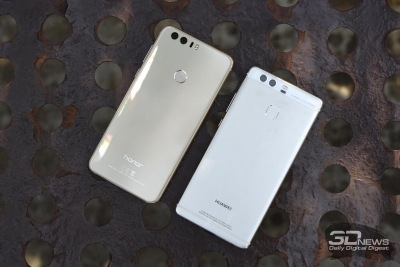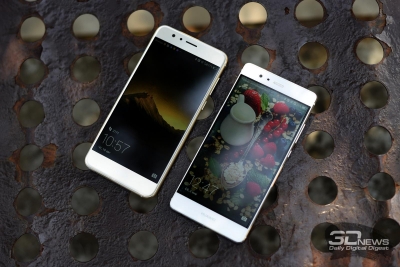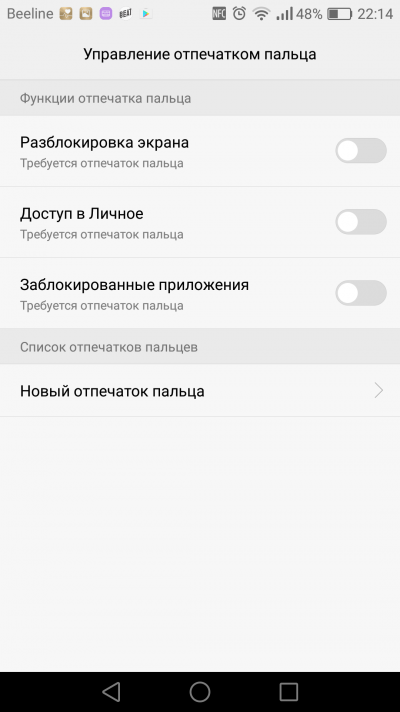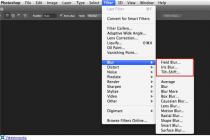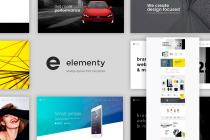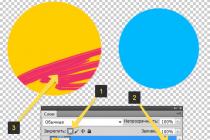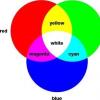A couple of months ago, Huawei introduced the Honor 8 smartphone. Although this model belongs to the middle class, in technical terms, it almost completely copies the capabilities Huawei flagship P9. The novelty received metal case, durable glass finish, high-performance processor, 4 GB of RAM, fingerprint sensor and dual main camera. At the same time, the price of Honor 8 at the start of sales did not exceed the psychological mark of 30,000 rubles. Let's find out if Huawei Honor 8 real "killer" samsung galaxy S7 and iPhone 7.
The Honor smartphone series has always been different optimal ratio"price-quality-functionality". Huawei Honor 8 is no exception to these rules. We tried to make the device as interesting as possible for all categories of consumers. The novelty looks great, has flagship functionality, supports all the most advanced features and costs adequate money.
In technical terms, Honor 8 is a copy of the flagship smartphone Huawei P9 with rare exceptions. There is a similar in characteristics powerful processor, 4 gigabytes of RAM, capacious battery, Type C USB port, dual camera. It is clear that the camera is simpler, but it performs the main functions well: it blurs the background and expands the dynamic range.
Let's see how comfortable the use of Honor 8 will be in real life.
Specifications Huawei Honor 8
id="sub0">| Characteristic | Description |
| Body materials: | Aluminium, glass |
| Operating system: | Android 6.0, EMUI 4.1 custom skin |
| Screen: | IPS touchscreen, 5.2-inch diagonal, resolution 1080x1920 pixels (423 ppi), recognition of up to ten simultaneous touches, protective glass Gorilla Glass 3 |
| CPU: | HiSilicon Kirin 950 octa-core 64-bit with clock frequency 2.3GHz (4x2.3GHz (ARM Cortex-A72) + 4x1.8GHz (ARM Cortex-A53)) |
| GPU: | ARM Mali-T880 MP4 |
| RAM: | 4 GB |
| Flash memory: | 32/64 GB + microSD card slot |
| SIM card type: | one - nanoSIM, the second - nanoSIM / microSD (combined slot) |
| Mobile connection: | EDGE/GPRS/GSM (850, 900, 1800, 1900 MHz), WCDMA (850/900/1900/2100 MHz), LTE Cat.6 (300/50 Mbps) |
| Communications: | Dual-band Wi-Fi 802.11 a/b/g/n/ac, Bluetooth 4.2, DLNA, Miracast. connector USB type-C (USB 2.0) for charge/sync, IR, NFC, 3.5mm for headset |
| Navigation: | GPS, AGPS, GLONASS, BEIDOU |
| Sensors: | ambient light sensor, proximity sensor, accelerometer/gyroscope, magnetometer (digital compass), fingerprint reader |
| Main camera: | two modules of 12 megapixels, f/2.2, dual LED flash, laser focusing |
| Front-camera: | 8 MP (3264 × 2448), no autofocus, f/2.4 |
| Battery: | non-removable, 3000 mAh |
| Dimensions, weight: | 145.5x71x7.5mm, 153g |
Package contents and first impressions
id="sub1">Huawei Honor 8 comes in an extremely stylish box made of white hardboard with a textured pattern. The name of the model is printed on the front of the package. Accessories from the kit are placed in separate boxes. In the box, in addition to the smartphone itself, there is a USB Type C synchronization and charging cable, an AC adapter, a paper clip to open the SIM card tray, instructions and a warranty card.
Pulling the smartphone out of the box, you notice how much it looks like (iPhone 7) and Samsung Galaxy S7 combined. I had a white device on the test, and it was very similar to the flagship gadgets of Apple and Samsung. The device has rounded edges, it is very thin and light enough. Dimensions - 145.5x71x7.5 mm. Weight - 153 grams.

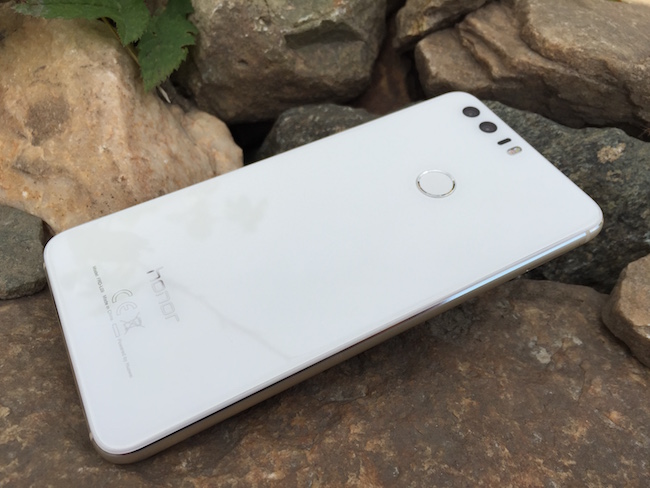
Surprisingly, the device fits in the palm of your hand. This is due to the relatively small width. However, it is difficult to reach the edges of the screen with one hand. You have to connect the second hand or intercept. Actually, for this reason, in the settings, the user can set a special mode when, by swiping from edge to edge of the display, the picture on the screen will decrease by 30%. In this case, the desired menu items can be reached with one hand. At the same time, the device can be carried in the pocket of trousers, jeans, jacket or shirt. You don't experience discomfort.
Visually, the Honor 8 is slightly larger than the iPhone 6 (iPhone 7), comparable to the Samsung Galaxy S7.
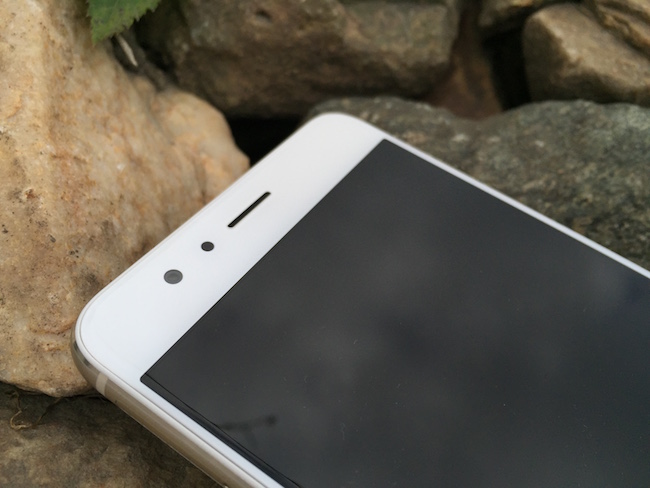
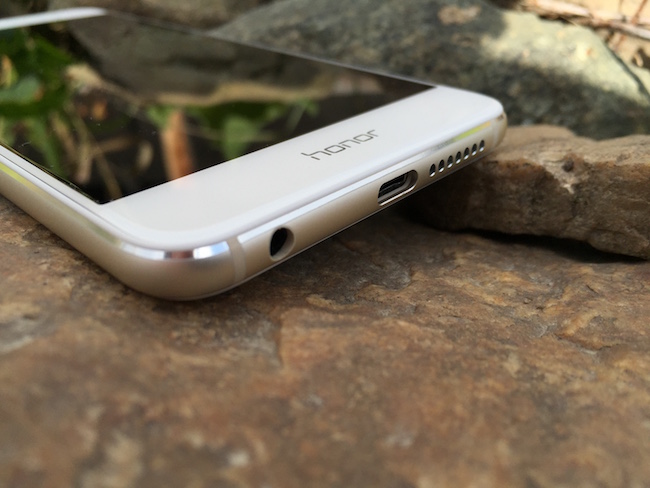
Design and appearance
id="sub2">The developers made a special emphasis on the appearance of new items. The body of the smartphone is metal with smooth contours. The front and back surfaces are decorated with 2.5D glass (the glass is rounded on the sides). This technique is used in the Samsung Galaxy S7. The frame is made of brushed aluminum, which has the same color as the main body. You can also see small inserts along the contour - antennas are located here for mobile communications, Wi-Fi, navigation receivers, GPS/GLONASS and NFC.
The device comes in several colors: gold, black, pink, white and blue. I had a white machine at my disposal. Assembling Honor 8 on the very high level, it does not deform and does not creak when you try to twist or bend it. In the hands of the device is perceived as a very expensive and solid device.
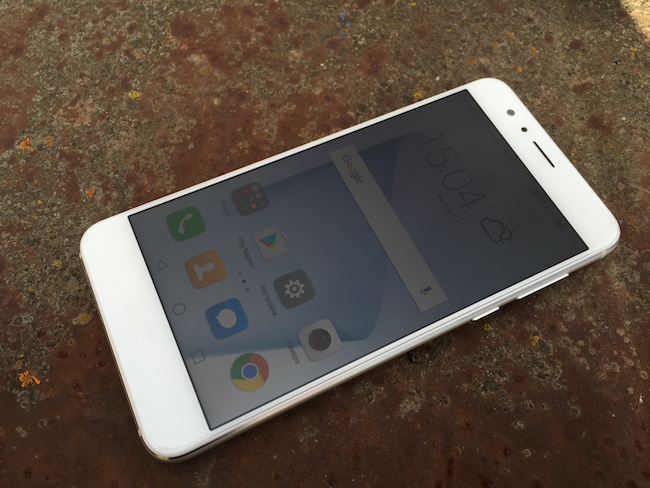
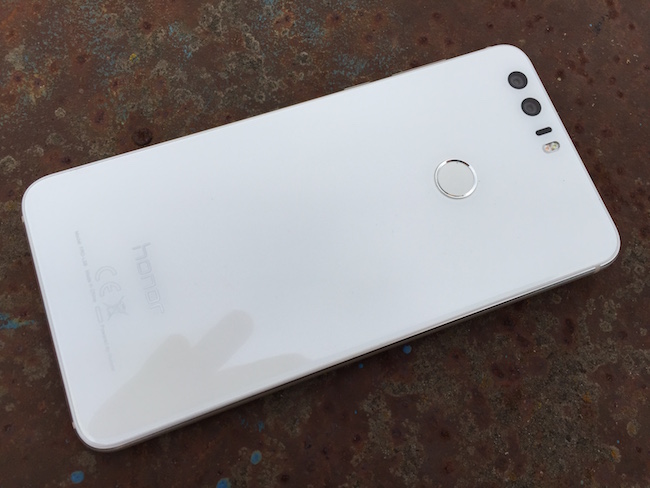
In the course of testing, I encountered one feature. The smartphone slides off inclined surfaces. To a greater extent, this applies to sofas, chairs, armchairs with textile trim. In any case, if something does not suit you, there is always the opportunity to purchase a case. The cover, by the way, will protect against abrasions and cuts on the back glass surface. Sooner or later they appear. Checked on myself. Experiments have also shown that the glass that protects the screen is much stronger than that used on the back.
Despite this, I can safely say that Honor 8 has become the most beautiful device of all the devices that Huawei has released. To be honest, Huawei P9 after that looks like a little short.
On the front there is a 5.2-inch screen covered with a protective glass Gorilla Glass 3. The glass is made in the style of 2.5D, that is, it slightly curves at the edges, as if hanging over the main part. Visually, it seems that the gadget has no frames at all, however, when the display is activated, everything falls into place: the frames on the right and left are 2 mm each, which is very good. There is an oleophobic coating, fingerprints remain, but are erased quickly and easily.
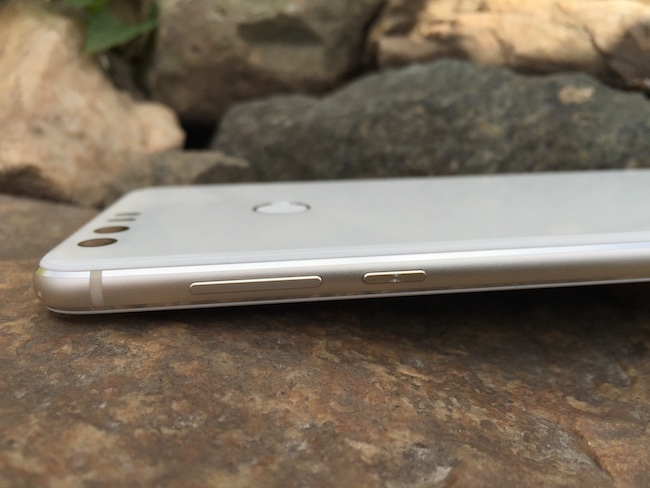
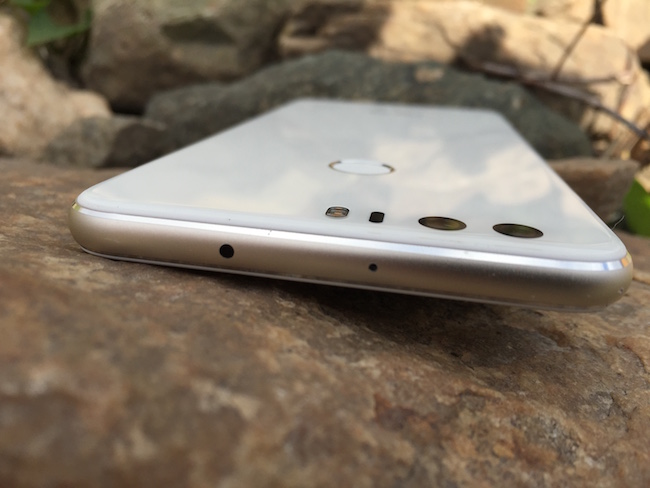
Above the screen there is a speaker for telephone conversations. Its volume is enough to communicate in a noisy room or on the road. An LED indicator is built into the speaker grille. It flashes when receiving incoming messages, phone calls, low battery. It can be disabled or reconfigured in the corresponding menu item.
To the left of the speaker are proximity sensors, lighting and a front camera.
There are no buttons or other elements under the screen. Function keys are fully integrated into the on-screen shell. Below you can see the logo of the sub-brand - Honor.
On the lower edge on the right there are speaker holes for external calls and music, as well as a microphone, on the left - a hole for connecting a wired headset. You can see in the center USB connector Type C for connecting to a computer and charging.
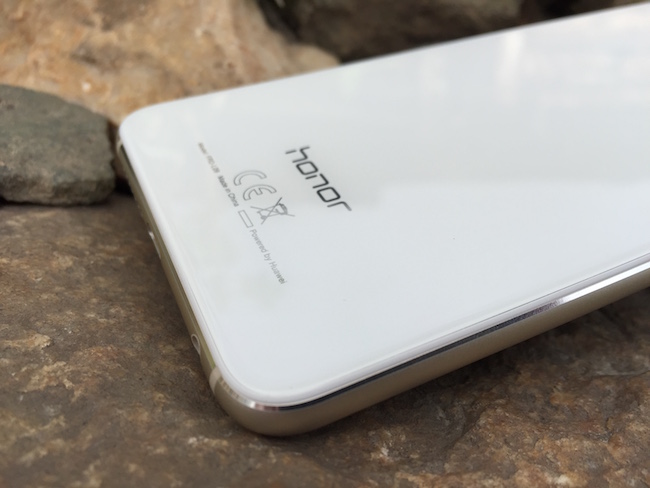
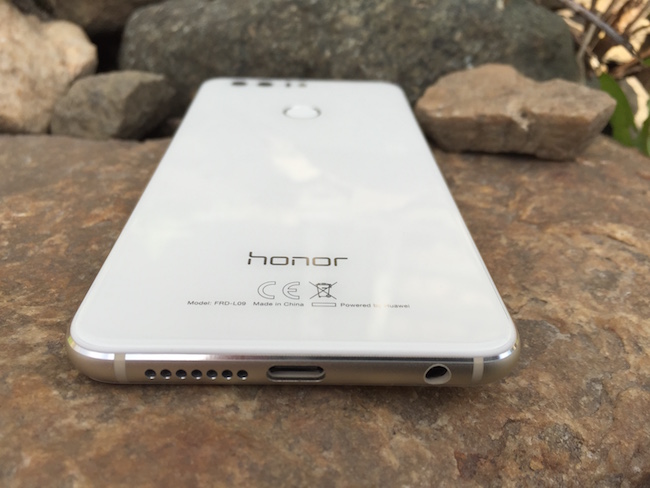
I would rate the work of the main speaker at four or four with a minus. Firstly, the sound is not powerful enough and loud. Secondly, the volume and detailing is not felt. Not enough power. It seems that the speaker does not play at full capacity. Thirdly, if you close the speaker grill with your hand or finger, the volume drops by 80%.
On the top edge, you can see a second microphone for noise reduction, as well as a small infrared port. With it and an application installed from Google Play you can control home appliances and electronics. On the right side are the volume buttons, the power button / screen lock. The latter received an embossing that it can be quickly groped blindly.
On the left is a compartment for two nanoSIM-sized SIM cards. One of them can be used to expand the memory. It uses microSD memory cards. This configuration does not allow you to use two SIM cards and a memory card at once.
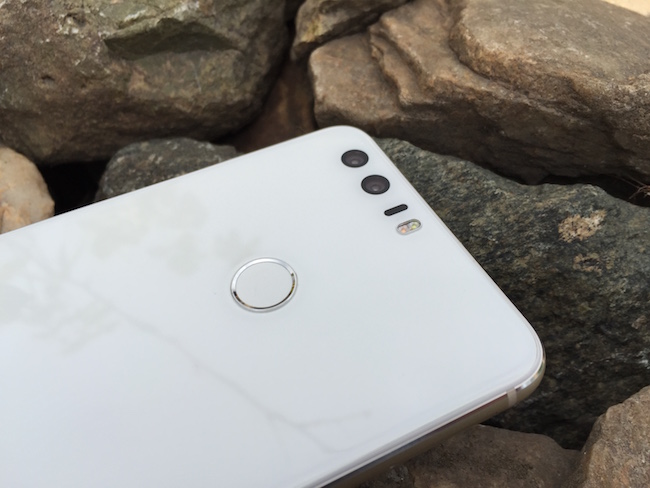
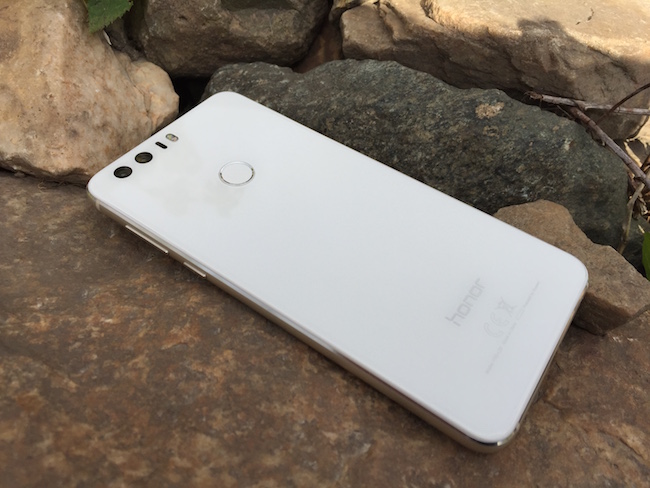
On the back side, you can see the lenses of two cameras at once. Both cameras use a 12MP sensor with laser focus, autofocus and dual LED flash. The first camera does everything that the cameras of other smartphones do - it just takes pictures. Additional camera has a black and white sensor, it collects all the light, due to this, the dynamic range and sensitivity increase.
The area with cameras and LED flashes does not protrude relative to the plane of the back of the smartphone. This is a big plus.
A little lower in the center is a fingerprint scanner, which has a round shape. In addition to unlocking the device, you can use it to answer calls, turn off the alarm, view the list of open applications (swipe up on the sensor), open the notification panel (swipe down), and clear notifications (double tap on the sensor). Moreover, the user can create a secure area for storing confidential information and classified applications, which will be accessed by fingerprint.
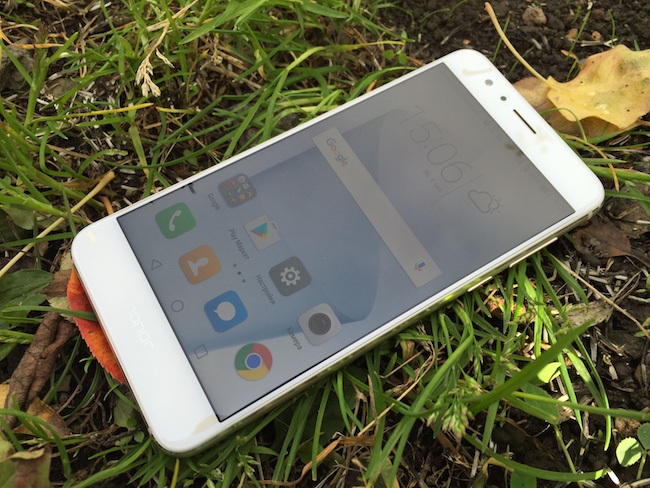
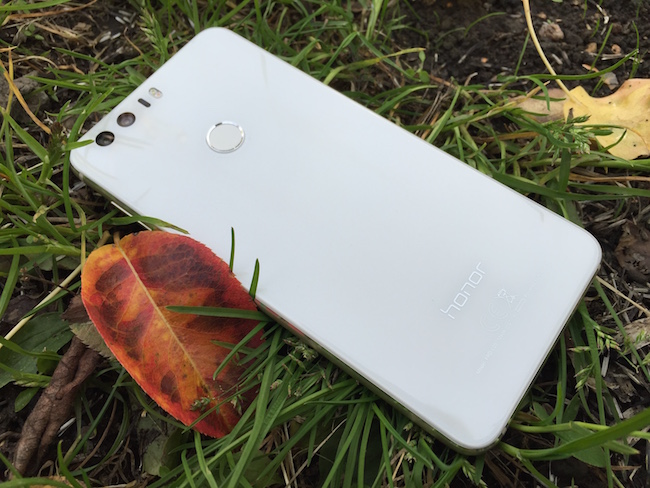
The fingerprint sensor works quite quickly and, most importantly, accurately. The official Huawei website says about 0.5 seconds for recognition, and this seems to be true. During testing, he accurately recognized my fingerprints and did not react to strangers. A total of five prints can be stored in the device's memory.
Screen. Graphic features
id="sub3">The Honor 8 uses a 5.2-inch screen. The display is made using IPS technology with anti-reflective coating and no air gap. Resolution - 1080x1920, pixel density - 423 ppi. This is a fairly high value - the picture on the display looks sharp. Viewing angles are maximum. Under direct sunlight, the image remains readable, the screen does not glare. The maximum brightness of white color is 400 cd/m2, the maximum brightness of black color is 0.47 cd/m2, and the contrast ratio is 850:1.
The device has an eye protection mode that reduces the level of ultraviolet radiation, prevents eye fatigue during prolonged use of the smartphone.
The picture on the display looks good, clean and believable. The frame around the screen is quite narrow: about 2 mm on the sides and 14 mm on the top and bottom. In addition, here we use a tricky visual effect, when a very thin bezel strip on the sides is painted over and the rest remains black. In this case, the extinguished screen looks almost "frameless", but this is just a trick of the designers.
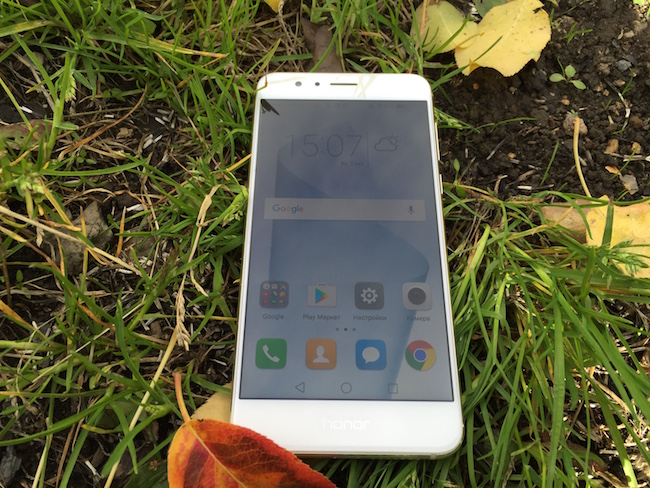
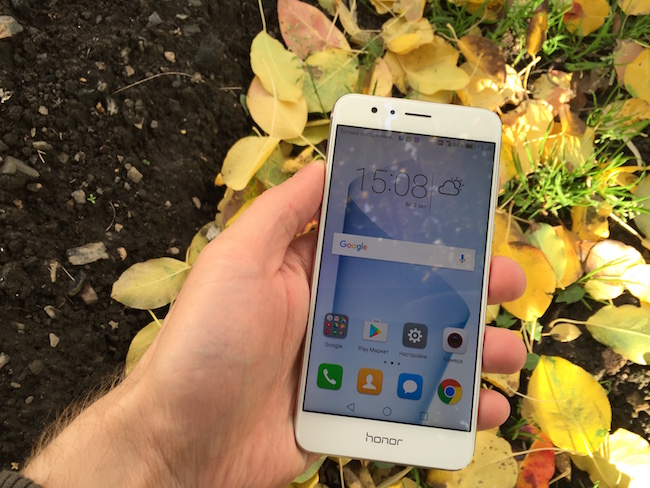
The gadget is equipped with a light sensor, thanks to which it can independently adjust the brightness level that is comfortable for working in given conditions. The sensor works quite correctly.
If we talk about the sensitivity of the screen, then it reacts to touch quickly and recognizes gestures without any problems. In total, the device supports up to ten simultaneous touches. Also, the gadget easily understands touch in loose gloves.
The Honor 8 has a proximity sensor that blocks the display when you bring the smartphone to your ear. You cannot activate the screen by double-tapping on the glass, but the display is activated by touching the fingerprint reader area. True, it is located on the back side and is not available when the smartphone is on the table with the screen up.
Hardware platform: processor, memory, speed
id="sub4">Honor 8 is equipped with a proprietary HiSilicon Kirin 950 chip with an eight-core processor: 4 ARM Cortex-A72 cores at 2.3 GHz and 4 ARM Cortex-A53 cores at 1.8 GHz. Graphics subsystem (GPU) - Mali-T880 MP4. Under load, the smartphone body practically does not heat up.
The RAM is 4 GB LPDDR4, and the internal memory can be 32 GB or 64 GB. Memory cards up to 128 GB are supported, although the connector for them is combined with a slot for a SIM card. This means that you will have to use either a card or a nanoSIM.
If we talk about the operation of the interface, then during the test I did not notice any glitches and brakes at all.
All games from the standard test suite ran without problems. FullHD video is played without slowdowns, the browser is also stable. Summing up the performance, I note that it is very, very sufficient.
Communication options
id="sub5">Huawei Honor 8 has two slots for nano SIM cards. It is noteworthy that the smartphone has two separate radio modules. They work according to the scheme Dual SIM Dual Active, that is, when any activity occurs on one of the cards, for example, an incoming call, the second one does not go offline. Working with SIM cards is implemented in the simplest way: after installing both SIM cards in the device, the smartphone will offer to assign which one to call, send messages and access the Internet.
A SIM card in any slot can work with 3G / 4G networks, but only one of them can operate in this mode at the same time. To change the assignments of card slots, you do not need to swap places - this can be done directly from the phone menu.
The smartphone supports all modern communication networks: 2G/3G and 4G cat. 6 on Russian frequencies (4G TDD LTE: Band 38/40 and 4G FDD LTE: Band 1/3/7/8/20), confidently receives the signal and does not lose it for no apparent reason. It is noteworthy that Honor 8 has a software option that allows you to improve the quality of signal reception, it is called "Signal +". Huawei says that in their next smartphone they have used not a double, but a “triple Signal + 2.0 virtual antenna.”
Talking on the phone is comfortable. The speaker has a good volume margin, and the interlocutors did not complain about poor audibility during testing.
The device can work with all modern wireless networks. Among them are Wi-Fi 802.11 a/b/g/n/ac (2.5 and 5 GHz), Bluetooth version 4.2. All modules work quickly and without failures.
The smartphone supports Wi-Fi Direct, you can organize a wireless access point via Wi-Fi or Bluetooth channels. "Smart" WiFi function+ allows you to automatically switch between a Wi-Fi network and a network mobile transmission data. USB 2.0 Type C connector supports connection of external devices in USB mode OTG. There is also NFC and an infrared port.
Of the additional communication tools, it is worth noting GPS, A-GPS, GLONASS, BeiDou (standard cartography is built into the smartphone Google Maps). The navigation error radius during testing is about 3 meters, which is very small. The gadget perfectly copes with the role of a navigator.
Working time
id="sub6">The smartphone has lithium ion battery 3000 mAh capacity. Under test conditions, with the number of calls 35-40 minutes a day, browsing the Internet for about 2 hours via 4G, listening to an mp3 player through a headset for about 2 hours a day, the device worked for 20 hours. When watching a video, the gadget worked for 7 hours, in navigator mode - 3 hours 35 minutes. As a result, the device has to be charged every day. If you use your smartphone in a less intensive mode, it will work for 2-2.5 days.
In terms of autonomy, the device is no different from the vast majority of other Android smartphones. However, Huawei has provided three battery usage profiles with quite speaking names: productive, "smart" (automatically adjusts processor power depending on the task being performed), and energy-saving.
The battery is charged for about two hours. Wireless charging the device does not support, but the mode " fast charging» is present. Fast charging technology provides a 45% charge level within 30 minutes. And if you charge Honor 8 in just 10 minutes, the charge will last for 2 hours of talking or 6 hours of listening to music.
User interface and operating system
id="sub7">Honor 8 runs Android 6.0 Marshmallow operating system and user interface Emotion UI 4.1.
For those who are familiar with this shell, it will not be difficult to figure it out. Supports work with gestures, there is an additional virtual button control, which is displayed on the screen in a circular menu. The navigation panel has been modified, divided into several tabs, the first of them has a convenient timeline of events, the next one can find a quick access menu to the main settings, and swiping up from the bottom brings up another menu where you can find a flashlight, voice recorder and some others useful features and settings.
Among other things, the user can choose the effect when unlocking or moving between desktops, choose the style of icons, fonts, and also the response to incoming call when you hold the phone to your ear. There is a function of transferring to silent mode when turning the screen down, as well as tilting the phone to arrange widgets. In general, there are a lot of little things that especially impressionable people should like.
There are also several built-in themes with the possibility of free and paid downloads of new ones, as well as very nice pictures for the lock screen. This is one of the rare cases when, acquiring new smartphone, you do not have to change the built-in backgrounds and themes to new ones. There is an automatic wallpaper change mode, when the pictures are displayed in a chaotic manner; To do this, you just need to shake your smartphone.
Among the pre-installed there are standard applications for the manufacturer: free programs Yandex and Mail.ru, Opera browser, WPS Office to work with office documents, Dropbox, Shazam, Facebook, Clean Master, EyeEm, a Booking.com booking service, a Health app that allows you to set yourself weight loss goals, and with the help of GPS navigation- track the distances mastered by the user and the type of movement (walking, running, cycling) and count the calories burned and thus control the degree of completion of tasks.
Camera. Photo and video capabilities
id="sub8">Huawei Honor 8 uses a dual camera. Image resolution - 12 megapixels. One camera captures the colors of the captured image, and the second reads the monochrome information. The resulting data is then programmatically combined and written to the resulting files. The main camera lenses have an equivalent focal length of 27mm and a maximum aperture of f/2.2. Paired with the main camera is a dual LED flash that can illuminate the subject in both pulsed and continuous glow modes. The front camera uses an 8MP sensor and a fixed focus lens (26mm equivalent focal length and f/2.4 aperture).
The camera control menu is generally familiar from previous models. A gesture on the left calls up a menu with various modes, on the right - a menu of camera settings (image resolution, button control, etc.), and a menu is called from the bottom manual settings shooting. In it, as usual, you can independently control the focus, shutter speed, ISO, exposure compensation and white balance. there are practically no dark, undetailed areas in the photograph, or light ones without information. Colors and white balance are excellent. Accuracy and focusing speed are high.
The resulting photos look good. There are practically no dark undetailed areas, or light ones without information. Colors and white balance are extremely accurate. Focusing speed is fast. Blurring appears in poor lighting. But in general, the picture is of adequate quality.
The Honor 8's camera can shoot video at a maximum resolution of up to 1920x1080 at 30 or 60 fps with stereo sound. There is also the possibility of slow motion slo-mo recording in 720p resolution at 120 frames per second. For video shooting, you can turn on the stabilization function, but its work when shooting on the go is barely noticeable. The camera copes with video recording in general in an average way: the image is loose and not always sharp, although it is bright and without noticeable artifacts. But still, you expect a lot more from shooting FullHD 60 frames per second. The sound during video recording is recorded quite well, the noise reduction system copes well with wind noise.
I will also mention the front camera for selfies. It is 8 megapixels with f/2.4 aperture. There is no autofocus. You can record videos in resolutions up to 720p. The camera performs its function well.
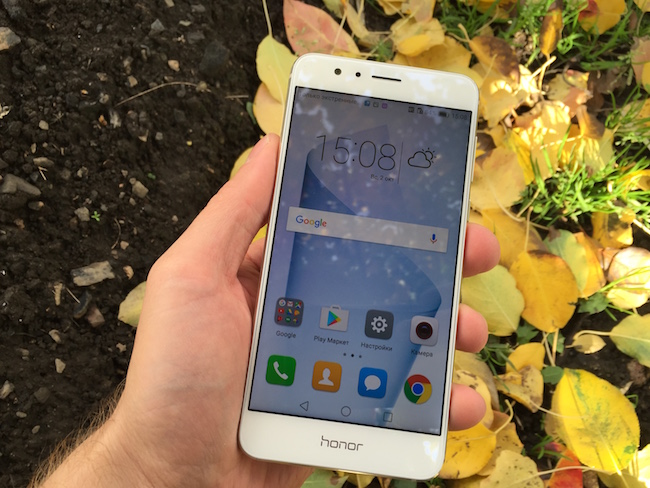
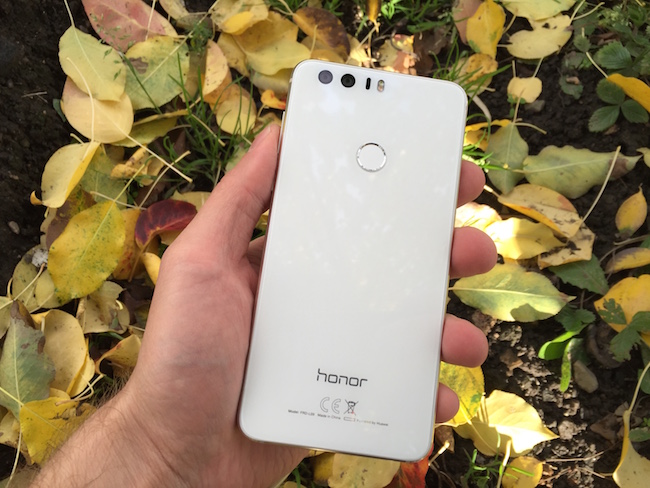
Results
id="sub9">Three weeks of communication with Huawei Honor 8 flew by very quickly. I'm really used to this smartphone. I liked him. Not the last place in perception is appearance. The device combines the design of iPhone 6/7 and Samsung Galaxy S7. It looks and feels great in the hand. It feels like a flagship device.
The aluminum body and the 2.5D effect protective glass are perceived very well. The device has a productive iron, a sufficient amount of RAM and takes very high-quality photos.
The pluses include support for LTE of all Russian bands, the presence of two radio modules for SIM cards. Time battery life here lower than the Galaxy S7 and comparable to the iPhone 6s.
The disadvantages of Honor 8 are few. First of all, this is the low quality of the video received from the main camera. The second point is the external speaker, which is relatively weak in volume. I also note the tendency to scratches on the glass of the back surface of the device. Here is the time to immediately buy a protective case.
The features of this model include the use of a USB Type C port for charging. This standard is still very rare. Therefore, you will have to carry a cable with you. This is worth remembering.
Advantages
metal case
Great looks and quality build
The fingerprint scanner
High performance
good screen
Two separate radio modules for two SIM cards
Good main camera
Support for LTE cat. 6
disadvantages
Average video quality from the main camera
The camera settings interface is displayed in a horizontal layout
The slot for a memory card is combined with a second SIM card (nanoSIM type)
Over time, scratches appear on the glass on the back surface
Low external speaker power
On the day of publication, Huawei Honor 8 could be bought at a price of 28,000 rubles.
The dual camera becomes a hit in 2016. More and more manufacturers are equipping their smartphones with a dual module. One of these gadgets was Huawei Honor 8, released in July 2016. The price of the novelty, which we found at the time of writing, ranged from $ 350 (for the younger version with 3 GB of RAM / 32 GB of ROM) to $ 460 (for the version with 4 GB of RAM / 32 GB of ROM). For this money, the buyer receives a middle-class device equipped with an eight-core processor and a dual camera.
The device received characteristics close to the flagship, but a little short of the tops of this year. However, some features of the smartphone are typical for more expensive devices. To find out which ones, as well as to clarify the pros and cons of Huawei Honor 8, read the review.
In terms of characteristics, the device is in the middle between the upper and middle class. On paper, its specifications look great, but how in reality - let's try to find out.
Design, body materials, dimensions and weight
The case of Huawei Honor 8 is more typical for the flagship category. The fact is that most of the elements are made of glass. And the glass is not ordinary, but composite: it consists of several layers, thanks to which it is distinguished by a wonderful play of light.
The smartphone weighs 153 grams, the dimensions are 14.6 x 7.1 cm, and the thickness reaches 7.5 mm.
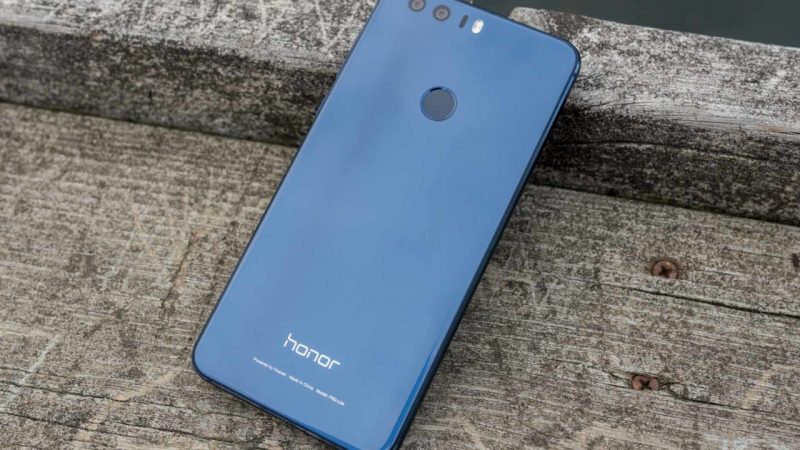
The rear panel is glass, it houses a fingerprint scanner in a silver frame, two lenses, a laser rangefinder window and a flash. There are no more functional elements on the back.
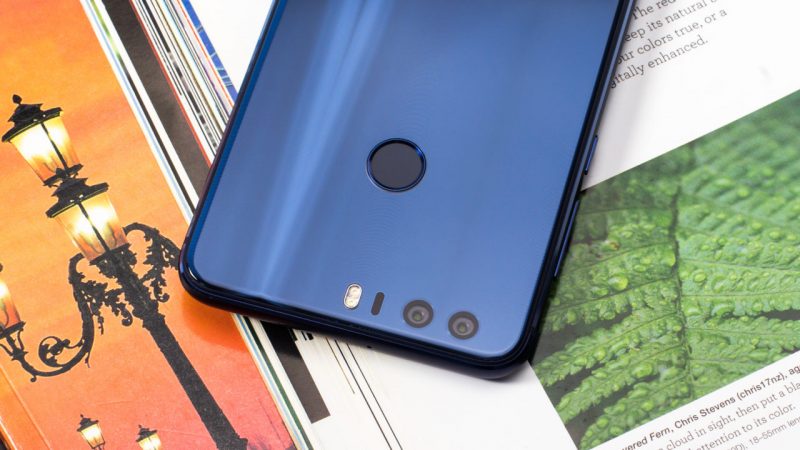
The speaker is placed on the bottom end, there are located USB port Type C and 3.5mm jack. By the way, the side frames are made of metal, with plastic inserts. On the left side there is a slot for cards, on the right side there is a power / lock button and a rocker for sound control.
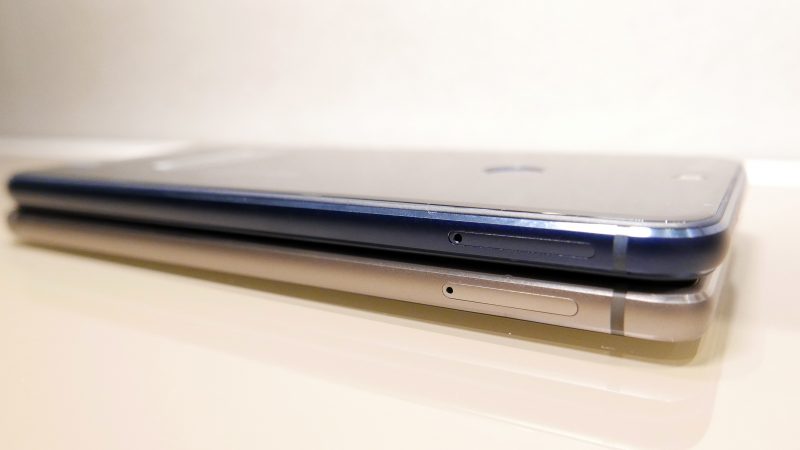
The front panel is covered with 2.5D glass, there are no special elements on it either. Standard speaker, camera and sensor on top, and that's it. There are no buttons under the screen, there is a black frame around the screen, but it is thinner than 1 mm, so it does not distract.
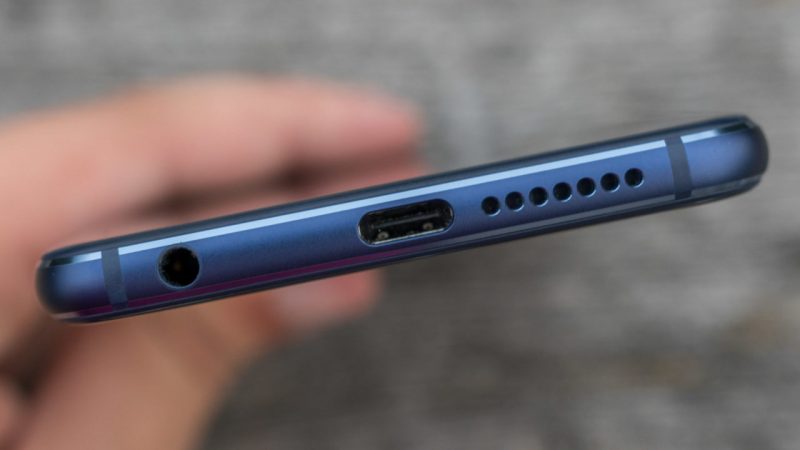
CPU
The smartphone is based on the HiSilicon Kirin 950 chipset. This is Huawei's own development, in 2015 the chip was the flagship one, but in 2016 it is already somewhat behind the giants Qualcomm and Samsung. It contains 4 Cortex A72 cores (2.3 GHz) and 4 more Cortex A53 (1.8 GHz). There are no complaints about the processor part, the performance is impressive, there are no brakes at all during operation.
However, Huawei engineers made the same mistake as the developers from MediaTek: they chose excellent CPU cores, but mediocre graphics. The chip is equipped with the Mali T880 MP4 video core, the same as the MTK Helio X20. It is weak, as for this class, and not powerful enough by the standards of the CPU. As a result - about 90 thousand points, which the processor "drags", and the graphics become a bottleneck. Games on the maximum graphics will work, but in the most demanding of them, slight FPS drops are possible.
Memory
The smartphone has 3 or 4 GB of RAM, it is recruited with LPDDR3 chips. At the start, about 1800 or 2500 MB are free, depending on the version. This is more than enough for everyday use of the device. There will be no problems in demanding games.
The amount of built-in storage, depending on the version, is 32 or 64 GB. There is a slot for a memory card, it is combined, and is combined with the second SIM card slot. Memory modules up to 256 GB are supported.
Battery
The capacity of the non-removable smartphone battery is 3000 mAh. The device demonstrates good autonomy, and with moderate use it can last up to 2 days. Heavy games, like the same Pokemon, put the battery in about 4.5 hours. Watching online video will drain the smartphone in 7-8 hours, when playing from a memory card, the charge will take 9-10 hours.
Huawei Honor 8 supports fast charging technology. The complete network adapter is able to restore up to 50% of the battery capacity in half an hour. A full charge takes about 1.5 hours.
cameras
Huawei Honor 8 has 2 main cameras. It has a pair of 12-megapixel 1/2.9" sensors with 1.25 micron pixels. It has laser autofocus. The cameras are the same as the P9, but there is no Leica logo anywhere. The question arises: does the German company have anything to do with the development of flagship cameras, because in Huawei Honor 8, with similar modules, no one mentioned it.

The cameras differ in that one is black and white and the other is color. Shooting is carried out according to the HDR principle, but slightly modified. The monochrome matrix is responsible for clarity and contrast, while the color matrix is responsible for the overall picture. Data from both matrices are combined, due to which clear, bright, and realistic frames are achieved. The pictures are excellent dynamic range, natural color reproduction, high-quality detail and sharp focus.

To disadvantages Huawei cameras Honor 8 can be attributed to not always correct focus operation. Sometimes a smartphone does not blur the background, but the main object, focusing on the environment. But at dusk, the charms of the dual matrix become apparent. The monochrome sensor has more light sensitivity (which is why night cameras are often black and white), so it allows you to capture more details.
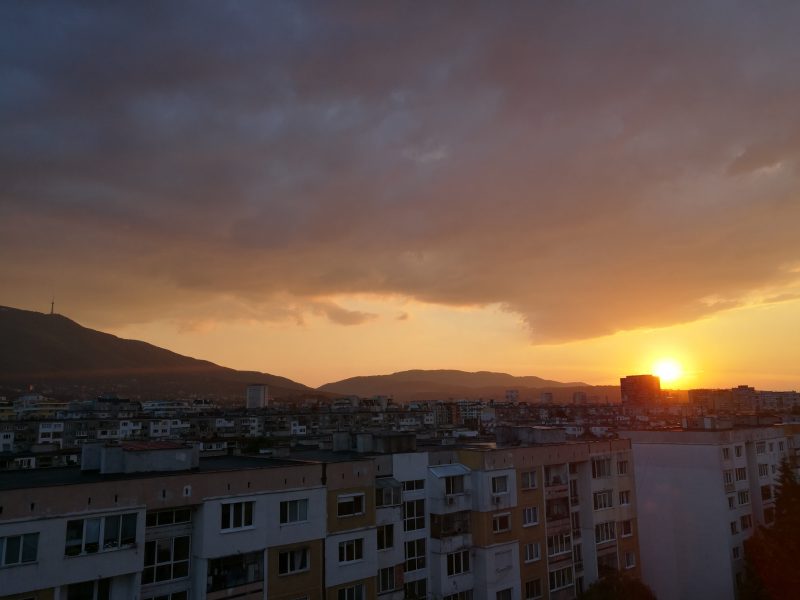
The video of the smartphone is also quite high quality. You can get a normal video both during the day and in the evening. The main disadvantage is the lack of stabilization. Because of this, the picture recorded on the go trembles and is blurry. But if you switch from FullHD to HD or lower the FPS from 60 to 30, electronic stabilization starts to work, the defects become less pronounced.
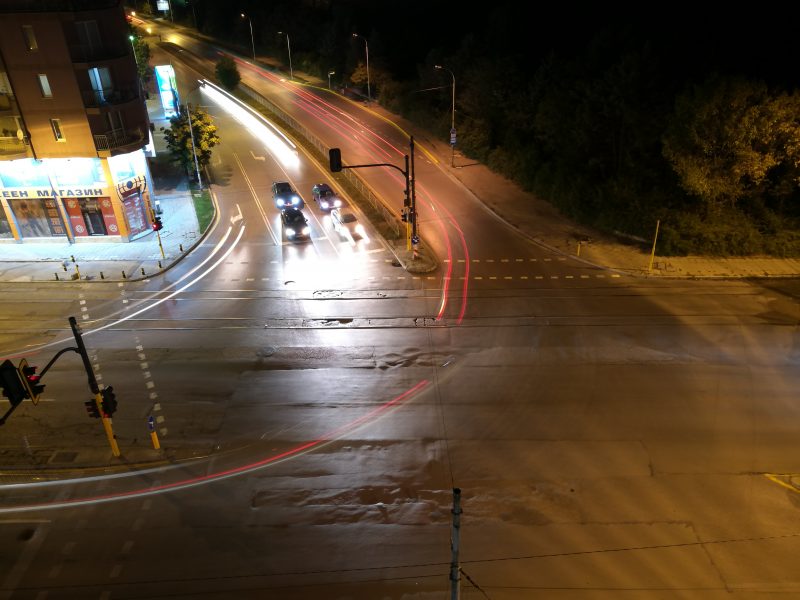
The front camera of the smartphone is 8 MP, with f / 2.4 aperture. It features a pixel size increased to 1.4 microns, and is very similar to the once flagship Sony IMX179. The front camera takes excellent selfies, which are nice to watch on the screen or monitor. A fly in the ointment is introduced by a filter that corrects the texture of the skin. It is designed to rid the face of pimples and other minor defects, but the side effect is blurring of the skin.
Screen
The display of Huawei Honor 8 has a diagonal of 5.2", it was created using IPS technology. The matrix resolution is 1920 x 1080 pixels, the pixel density is 423 ppi. The viewing angles are maximum, the brightness is enough for reading in bright sunlight, and the color reproduction is close to natural. Then the same applies to color temperature: white does not bluish or yellow.
The screen of the smartphone is covered with tempered glass with 2.5D edges. It supports up to 10 simultaneous touches, works them out well and accurately. The oleophobic layer is present, it is quite high quality, but the prints still remain. They are especially noticeable on a dark case.
Communications
The smartphone has two SIM card slots, one is MicroSIM, the second is NanoSIM, combined with a MicroSD slot. GSM, 3G and LTE networks are supported, there are no problems with frequency compatibility. Wi-Fi is dual-band, with support for 2.4 and 5 GHz frequencies, as well as the 802.11ac standard. The Bluetooth module belongs to version 4.2 and has a reduced power consumption. The navigator supports American, Chinese and Russian navigation systems.
Nice additions are NFC and infrared port. The latter is found only in rare flagships, only Xiaomi installs it en masse. The interface port is in USB Type C format and supports USB OTG.
Sound
The manufacturer does not say anything about a dedicated DAC, but the built-in sound processor of the chipset supports stereo sound in the DTS standard. Due to this, purity, volume and richness of sound in normal headphones are achieved. On the speaker, the sound is loud and clear, but a bit dry. However, this applies to almost any smartphone, since it is not the DAC that imposes restrictions, but the speaker itself. Huawei Honor 8 does not have FM radio.
Operating system
The smartphone is running a modification of Android 6 shell EmUI version 4.1. The differences from stock Android are very significant, the interface has been radically redesigned. There is no application menu, all shortcuts are placed on desktops. This is the only controversial point, otherwise the shell looks beautiful, and it is convenient to use it. No jambs or shortcomings typical for Chinese software were found in the device.
Features of Huawei Honor 8
One of the features of Huawei Honor 8 is the fingerprint scanner. It not only senses the touch of the pads, but also works as physical button. For each type of pressing (short, long, single or double), you can set your own function in the settings. The second feature is the special structure of the glass, thanks to which the lid glares very beautifully when exposed to light.
Pros and cons of Huawei Honor 8
Pros:
- powerful processor;
- good cameras;
- high-quality sound;
- excellent design;
- quality display.
Minuses:
The only obvious drawback can be considered only a easily soiled body.
Who is a smartphone for?
Huawei Honor 8 is a universal smartphone and will suit a wide category of users. Gamers will appreciate decent performance, as well as sane autonomy. Photo lovers will be satisfied with both the main and front cameras. Those who need the device for communication and web surfing will appreciate good screen and fast work. People who choose the device in appearance will also be satisfied with the smartphone. Only "parrot hunters" will not like the device, since models on the Snapdragon 820 gain almost 50 thousand points more.
Our review of Huawei Honor 8
The review of Huawei Honor 8 showed that the smartphone turned out to be very successful. He has a beautiful appearance, powerful modern hardware and excellent cameras. The only negative is the easily soiled body, but it can be easily fixed if you carry a napkin with you and periodically wipe the device. The smartphone turned out to be quite productive for any task, there is no real lag behind the same Xiaomi Mi5 (and this is the closest Chinese competitor). If the Chinese origin does not bother you, you can safely take the device.
Dual 12MP camera, 5.2" Full HD LCD, rear fingerprint scanner, 4GB RAM, 3000mAh battery. This is what Huawei P9 and Honor 8 have in common. Differences: Honor has a slightly lower-end system-on-a-chip (Kirin 950 instead of Kirin 955) and it is stated that Leica was not involved in the work on the camera. And this is extremely curious - taking into account the identical characteristics and principle of operation of the module, you can find out whether the influence of the famous Germans was so great or is it still a classic “name trade”.
Well, yes, the key difference is the design. Here Huawei has turned around, creating something reminiscent of the Sony Xperia Z5 Premium - with a mirrored back panel and bright colors.
|
|
|
|
|
Honor 8 and Huawei P9 side by side |
||
In China, Honor 8 was introduced last month, the world premiere was traditionally delayed - it will take place on August 24th. So you have a chance to read the review of this smartphone not only before the start of sales, but also before the official presentation. The version of the device is full-fledged European, with Russification and local services.
⇡ Specifications
| Honor 8 | Huawei P9 | Honor 7 | Google Nexus 5X | Xiaomi Mi5 | |
|---|---|---|---|---|---|
| Display | 5.2 inches, IPS, 1920 × 1080 pixels, 424 ppi, capacitive multi-touch | 5.2 inches, IPS, 1920 × 1080 pixels, 424 ppi, capacitive multi-touch | 5.2 inches, IPS, 1920 × 1080 pixels, 424 ppi, capacitive multi-touch | 5.15 inches, IPS, 1920 × 1080 pixels, 427.75 ppi, capacitive multi-touch | |
| Safety glass | no information | Corning Gorilla Glass 4 | Corning Gorilla Glass 3 | Corning Gorilla Glass 3 | Corning Gorilla Glass 4 |
| CPU | HiSilicon Kirin 950 (four ARM Cortex-A72, 2.3GHz; four ARM Cortex-A53, 1.8GHz) | Huawei Kirin 955 (quad-core ARM Cortex-A57, 2.5GHz; quad-core ARM Cortex-A53, 1.8GHz) | HiSilicon Kirin 935 (quad-core ARM Cortex-A53, 1.5GHz + quad-core ARM Cortex-A53e, 2.2GHz) | Qualcomm Snapdragon 808 (four ARM Cortex-A53 cores @ 1.4GHz + two ARM Cortex-A57 cores @ 1.82GHz) | Qualcomm Snapdragon 820 MSM8996 (Dual Kryo Cores @ 1.8GHz + Dual Kryo Cores @ 1.36GHz) |
| Graphics controller | Mali-T880 MP4, 900 MHz | Mali-T880 MP4, 900 MHz | ARM Mali-T628 MP4, 600 MHz | Adreno 418, 600 MHz | Adreno 530, 624 MHz |
| RAM | 4 GB | 3/4 GB | 3 GB | 2 GB | 3 GB |
| Flash memory | 32/64 GB | 32/64 GB | 16/32/64 GB | 16/32 GB | 32/64 GB |
| Support memory cards | eat | eat | eat | No | No |
| Connectors | USB Type-C, mini jack 3.5 mm | USB Type-C, mini jack 3.5 mm | microUSB, 3.5 mm minijack | USB Type-C, mini jack 3.5 mm | USB Type-C, mini jack 3.5 mm |
| SIM cards | one nanoSIM / two nanoSIMs | one nanoSIM / two nanoSIMs | two nanoSIMs | one nano SIM | two nanoSIMs |
| Cellular 2G | GSM 850 / 900 / 1800 / 1900 MHz | GSM 850 / 900 / 1800 / 1900 MHz | GSM 850 / 900 / 1800 / 1900 MHz | GSM 850 / 900 / 1800 / 1900 MHz | |
| Cellular 3G | HSDPA 850/900/1700/1900/2100 | HSDPA 800/850/900/1700/1800/1900/2100 | HSDPA 900/1900/2100 | HSDPA 850/900/1900/2100 MHz | HSDPA 850 / 900 / 1900 / 2100 MHz |
| Cellular 4G | LTE Cat. 6 (up to 300 Mbps): bands 1, 2, 3, 4, 5, 6, 7, 8, 12, 17, 18, 19, 20, 26, 28, 38, 39, 40 | LTE Cat. 6 (300/50 Mbps): bands 1, 3, 7, 8, 20 | LTE Cat. 6 (up to 300 Mbps): bands 1, 3, 4, 5, 7, 8, 9, 17, 18, 19, 20, 26, 28, 38, 40, 41 | LTE Cat. 12 (up to 600 Mbps): bands 1, 3, 7, 38, 39, 40, 41 | |
| WiFi | 802.11a/b/g/n/ac | 802.11a/b/g/n/ac | 802.11a/b/g/n | 802.11a/b/g/n/ac | 802.11a/b/g/n/ac |
| Bluetooth | 4.2 | 4.2 | 4.1 | 4.2 | 4.2 |
| NFC | eat | eat | No | eat | eat |
| Navigation | GPS, A-GPS, GLONASS | GPS, A-GPS, GLONASS, BeiDou | GPS, A-GPS, GLONASS | GPS, A-GPS, GLONASS | GPS, A-GPS, GLONASS, BeiDou |
| Sensors | Light, proximity, accelerometer/gyroscope, magnetometer (digital compass), IR sensor | Illumination, proximity, accelerometer/gyroscope, magnetometer (digital compass) | Light, proximity, accelerometer, barometer, digital compass | Light, proximity, accelerometer/gyroscope, magnetometer (digital compass), barometer | |
| The fingerprint scanner | eat | eat | eat | eat | eat |
| Main camera | Dual module, 12 megapixels, f/2.2, phase detection autofocus, LED flash, 4K video recording | Leica, dual module, 12 megapixels, f/2.2, phase detection autofocus, LED flash, 4K video recording | 20 MP, ƒ/2.0, phase detection autofocus, LED flash, Full HD video recording | 13 MP, ƒ/2.0, laser autofocus, LED flash, 4K video recording | 16 MP, ƒ/2.0, phase detection autofocus, LED flash, 4-axis optical stabilization, 4K video recording |
| Front-camera | 8 MP, fixed focus | 8 MP, fixed focus | 5 MP, fixed focus | 5 MP, ƒ/2.0, fixed focus | 4 MP, fixed focus |
| Nutrition | 11.4 Wh non-removable battery (3000 mAh, 3.8 V) | 11.4 Wh non-removable battery (3000 mAh, 3.8 V) | Non-removable battery 10.26 Wh (2700mAh, 3.8V) |
11.4 Wh non-removable battery (3000 mAh, 3.8 V) | |
| Size | 145.5 x 71 x 7.5mm | 145 x 70.9 x 7mm | 143.2 x 71.9 x 8.5mm | 147×72.6×7.9mm | 145×69×7.3mm |
| Weight | 153 grams | 144 grams | 157 grams | 136 grams | 129 grams |
| Hull protection | No | No | No | No | No |
| Operating system | Android 6.0 Marshmallow, native skin EMUI 4.1 | Android 6.0 Marshmallow, native skin EMUI 4.1 | Android 6.0 Marshmallow | Android 6.0 Marshmallow, MIUI skin | |
| Current price | Approximately 30-35 000 rubles | 40 000 rubles | 23-25 000 rubles (depending on the version) | 22-27,000 rubles (depending on version and store) | 26,000 rubles (32 GB version), 32,000 rubles (64 GB version) |
⇡ Appearance, ergonomics and software
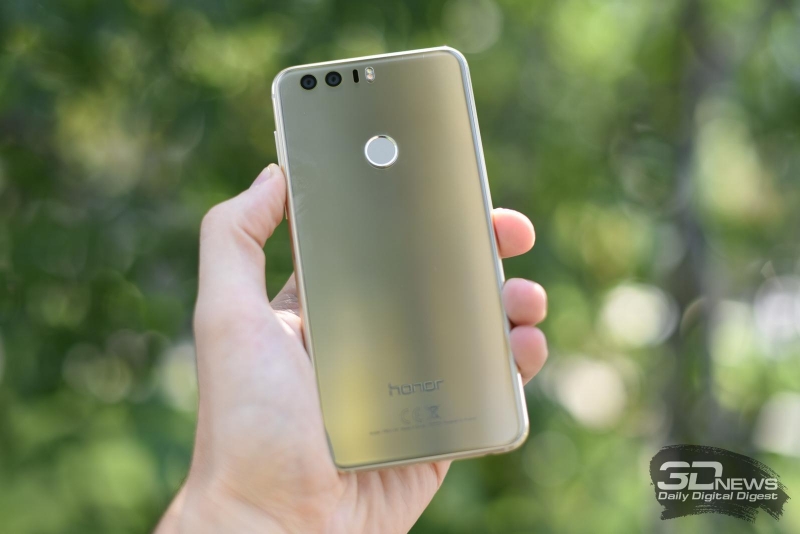
It is almost impossible to create something really unusual in the form factor of a typical smartphone - a monoblock with a touch screen. But you can somehow find your own style, which is also very difficult to do. At one time, for example, Sony did it - especially in the Z series with round power buttons. But for Apple, with the release of the sixth iPhone, this just didn’t work out - Cupertino smartphones merged with the general mass, and with the release of the s-variation, the situation, of course, did not change. So the task, as we see, is not trivial. But Huawei more or less copes with it - at least the features of the Mate and P series devices are recognizable. In part, this was transferred to smartphones of the Honor sub-brand. But in the case of the Honor 8 model, the situation is special - here the Chinese designers clearly decided to play on the Asian love for everything shiny.
Particularly impressive is the gold version, which ended up in our hands. The gadget shines both in front and behind - the body is covered with glass on both sides. The edges are also gold. Beauty, and only! .. If you do not touch the smartphone with your hands. Stock up on a cloth right away if you want your Honor 8 to always sparkle and throw gold dust in your eyes - like the one mentioned at the beginning Sony Xperia Z5 Premium surface is covered with fingerprints instantly and does not look so impressive. It's hard to say how things are with the blue and black versions, but I'm afraid it's about the same. Full list Colours: Sunrise Gold, Pearl White, Sapphire Blue, Midnight Black.
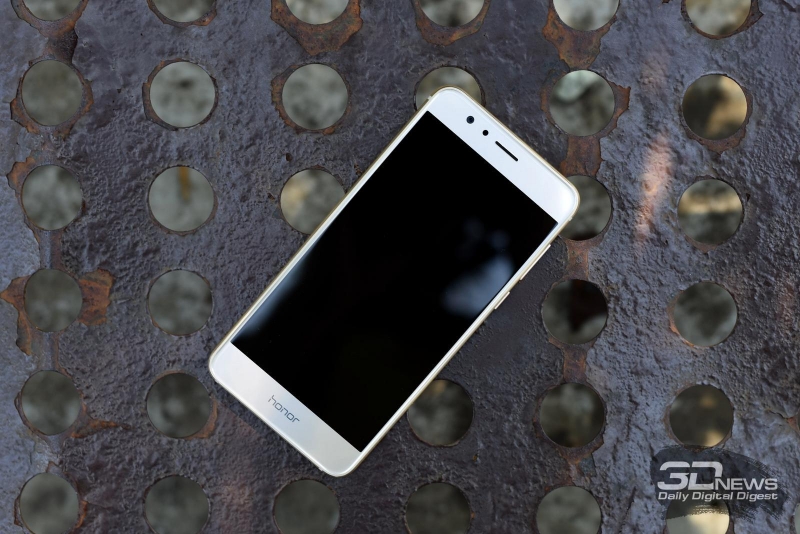
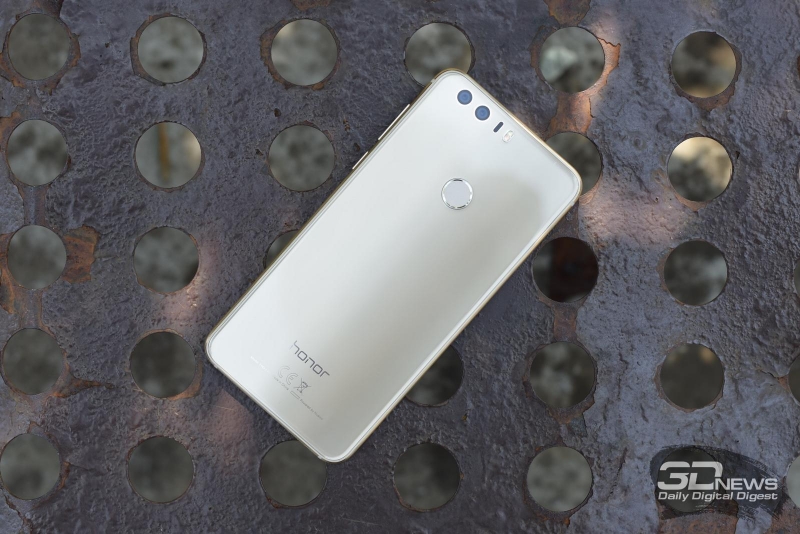
Honor 8, rear panel: at the top there are two camera lenses with dual LED flash and laser autofocus, below is a multi-function button with a fingerprint scanner
The fact remains that if Huawei wanted to somehow divide the technically similar P9 and Honor 8 between an older and more serious business audience and young people, then the company definitely succeeded. Despite the fact that the location of the functional elements, down to the details, such as the side strips of the antenna wiring, the border around the camera lenses, for example, are essentially identical. The main changes are the wiring of the second antenna that has moved down from the rear surface and the fingerprint scanner that has changed in form and functionality. The power button and the grille of the main speaker have also changed, and “cogs like those of Apple” have left the bottom edge.
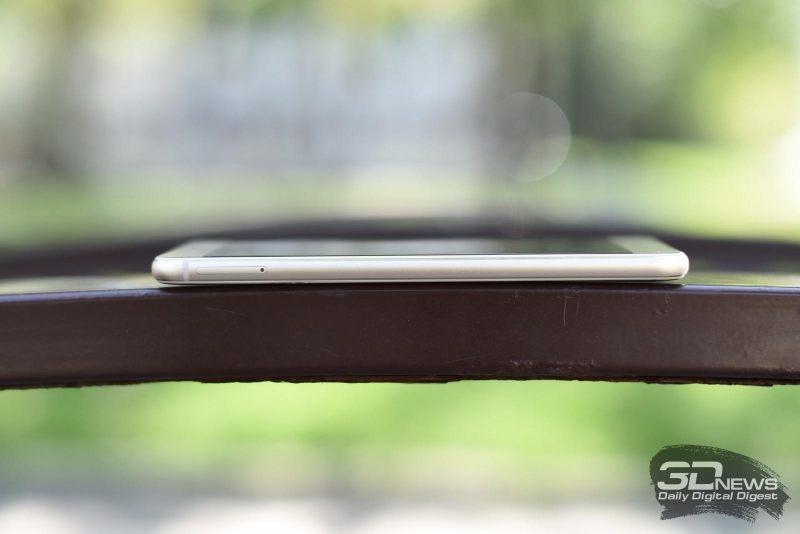
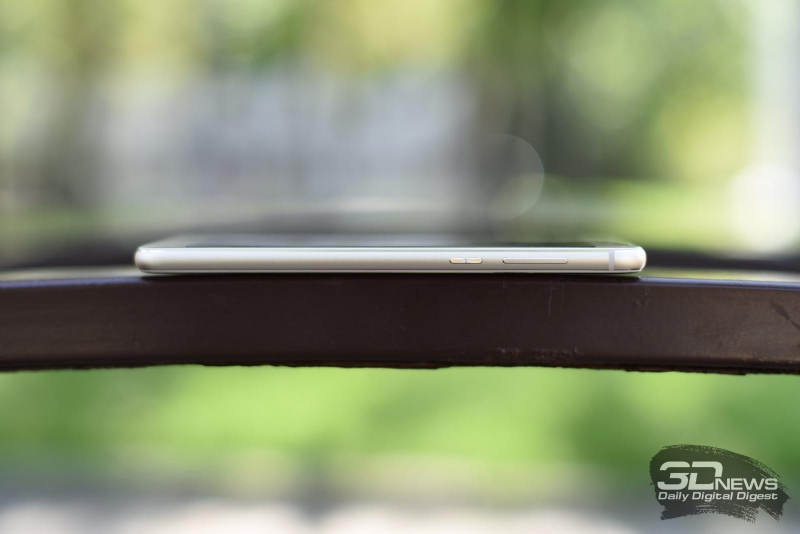
In terms of dimensions, the devices are very close, but Honor 8 is half a centimeter thicker and 9 grams heavier (153 vs. any pocket gadget.
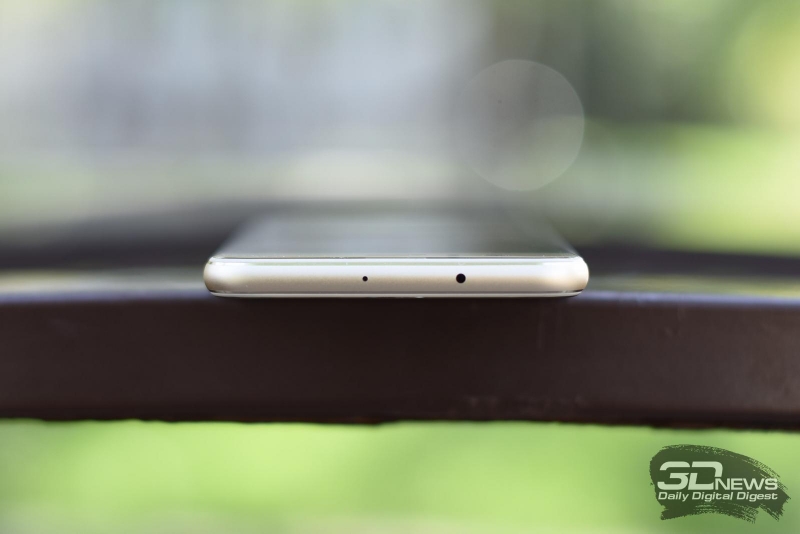
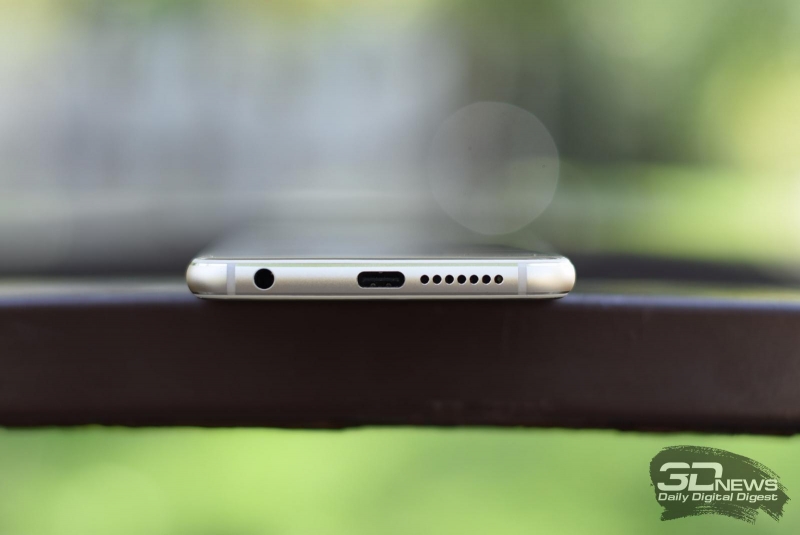
It's just very slippery. Dangerously slippery, it is too easy to drop it, in my opinion, be careful and do not touch it with wet hands.
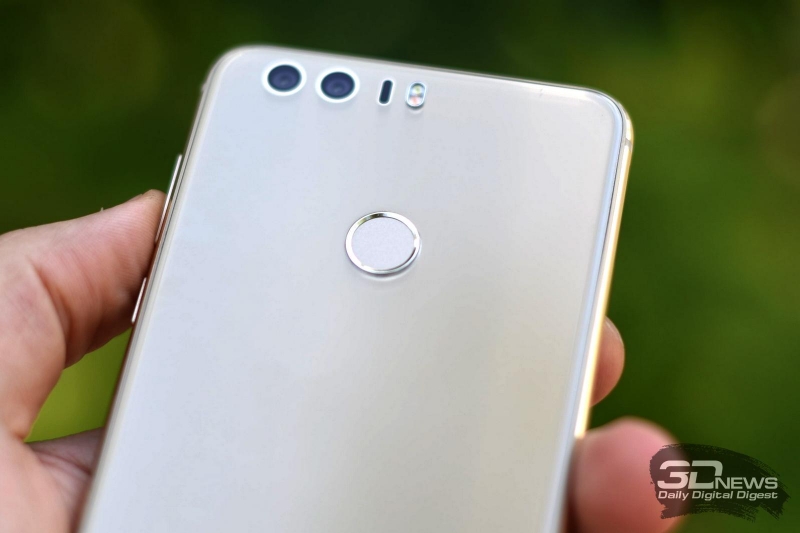
So, the fingerprint scanner - it became round, like on Mate 8, but in addition to this it received not only a touch surface, but also a surface that is pliable to mechanical pressing, this is a full-fledged button, and multifunctional. It reacts differently to single, double and long presses, and the called functions can be changed. By default, in the version officially sold in Russia, with a single click, it opens main page Yandex, and with a long one - Odnoklassniki. In general, the start screen, which also included, for example, Mail.Ru News and the Sberbank application, makes you want to urgently rush to the EMUI theme store and find something with Palekh or Khokhloma patterns. Unfortunately, there is nothing like this yet, but the smartphone is still notably full of Russia - and this is nice, you can always delete applications, but careful adaptation to the region warms the soul.
|
|
|
The fingerprint scanner itself is traditionally good for Android 6.0 - it works quickly and almost error-free. Moreover, Huawei offers more than one scenario for using it: in addition to unlocking the device, you can also use it to turn off the alarm, take pictures, answer a call, share personal files, and unlock individual applications.
Almost a year has passed since Huawei presented its attractive Honor 8 smartphone to the whole world in Paris, which was liked by many users not only for its good characteristics, but also for its unusual blue case color, which became an instant hit. Prior to this, this color was practically not used by manufacturers of mobile equipment - except perhaps sporadically.
Huawei, on the other hand, quickly elevated this color to the rank of the main ones and now constantly uses it as its own original “chip”, which others do not have. However, a whole year passed, until finally, in the spring of this year, followers of that legendary model began to appear in Russia. They became related smartphones Honor 8 Pro And Honor 8 Lite, also, of course, offering a signature blue color. In advertising, the emphasis is on the blue version, although these models are also available in other, also quite attractive colors. The youngest model in the expanded family, Honor 8 Lite, arrived to us for testing in the popular blue color.
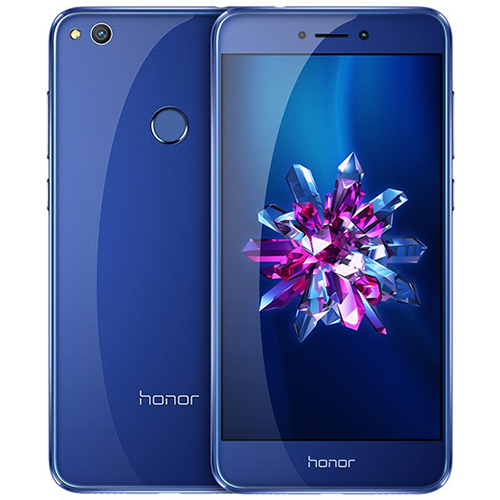
Key Features of Honor 8 Lite (Model PRA-TL10)
- SoC HiSilicon Kirin 655, 8 cores Cortex-A53 ( [email protected].1GHz+ [email protected].7 GHz)
- GPU Mali-T830 MP2
- operating room android system 7.0, EMUI 5.0
- Touch display IPS 5.2″, 1920 × 1080, 423 ppi
- RAM (RAM) 3/4 GB, inner memory 32/64 GB
- Support Nano-SIM (2 pcs.)
- microSD support up to 128 GB
- GSM/GPRS/EDGE networks (850/900/1800/1900 MHz)
- WCDMA/HSPA+ networks (850/900/1900/2100 MHz)
- LTE networks Cat.6 FDD (B1/3/7), TD (B38-41)
- Wi-Fi 802.11b/g/n (2.4GHz)
- Bluetooth 4.1
- GPS, A-GPS, Glonass
- Micro USB, USB OTG
- Primary camera 12 MP, f/2.2, autofocus, 1080p video
- Front camera 8 MP, f/2.0, fixed focus
- Proximity sensor, lighting, magnetic field, fingerprint, accelerometer, gyroscope, step detector
- Battery 3000 mAh
- Dimensions 147×73×7.6 mm
- Weight 147 g
Appearance and usability
The Honor 8 Lite is a slim and sleek smartphone with two flat glass panels with a curved metal frame in between. From the side, the device looks impressive, gleaming in the rays of the sun thanks to its panels with the effect of “brushed steel”. This is glass with a metallized shiny substrate, that is, almost a mirror, only slightly darkened.
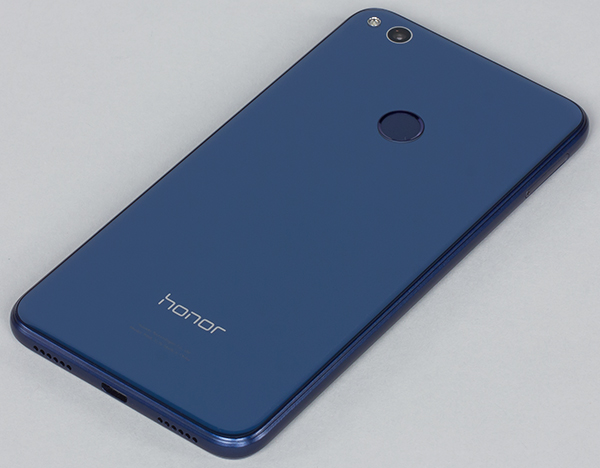
Naturally, all fingerprints and any dirt will be visible on such surfaces, although, in fairness, it should be noted that a high-quality oleophobic coating does not allow fingerprints to appear quickly, and they are easily erased. The corner parts of the case are noticeably rounded in plan, the profile is very thin, which is why the device fits comfortably in any pockets of clothes.
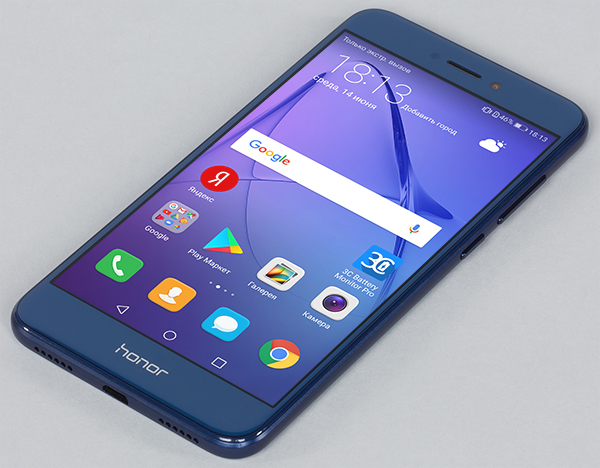
The glass panels themselves can be quite slippery, but the smartphone is usually held by the sides, and here they have high-quality matte surfaces that do not slip at all in the hands. This issue in Honor 8 Lite is well thought out. There are also no complaints about the assembly, the case is monolithic, all the details are clearly fitted, Huawei has a complete order with this.
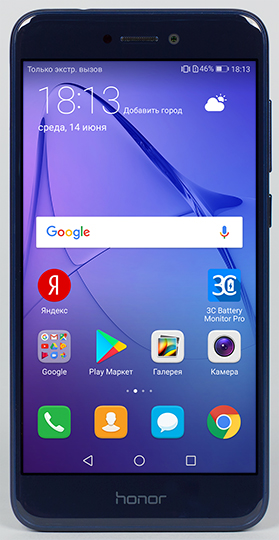 |
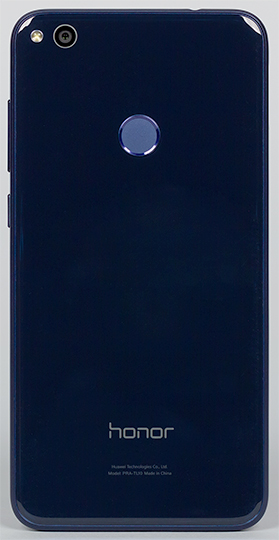 |
From older Honor 8 and Honor 8 Pro version Honor 8 Lite is notable for the absence of some elements. Here, for example, there is no dual camera, no two-section flash, no infrared transmitter on the top. But for some reason, two rows of holes are cut in the bottom end, although there is only one speaker here.
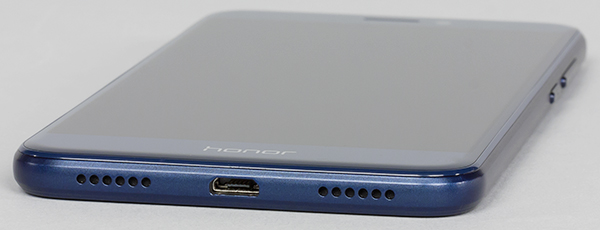
The top end contains only a 3.5 mm audio jack for headphones and an additional microphone for the noise reduction system.
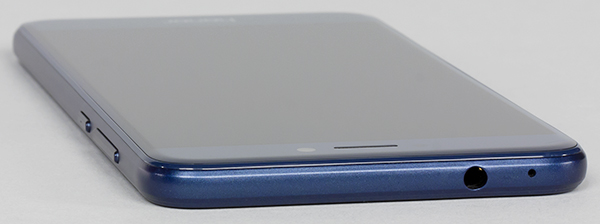
Cards are inserted into the side hybrid slot: either two Nano-SIMs, or one Nano-SIM plus one microSD memory card - everything is standard. Hot swapping of cards is supported.
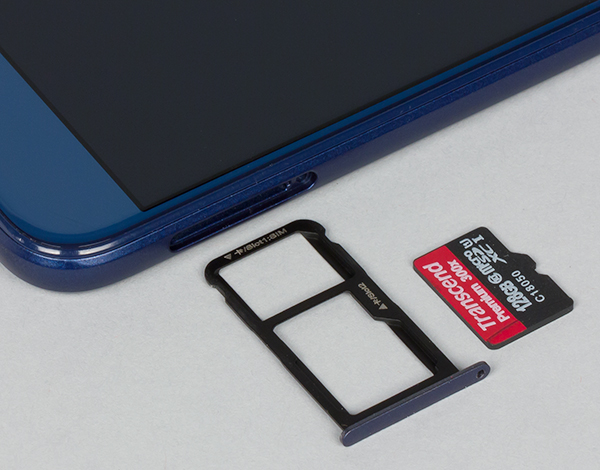
Mechanical buttons are installed on the opposite, right side face. The keys are large, protrude noticeably, are easy to grope for, the stroke is harsh, but the response is distinct.

The entire front panel is covered with 2.5D glass with sloping edges. Sensors are usually installed above the screen, a peephole front camera without its own flash, as well as an LED event indicator.
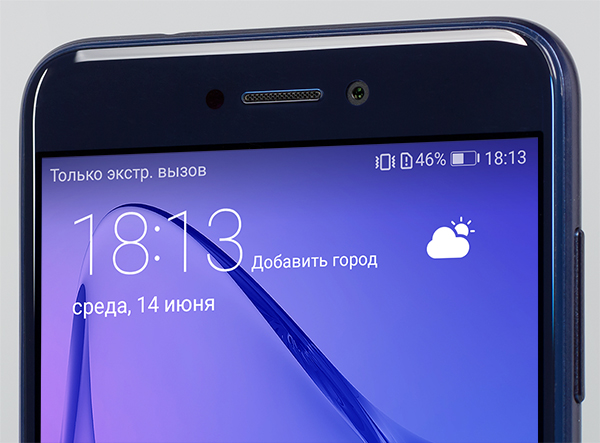
There are no hardware touch buttons under the screen, the buttons are only on the screen, their relative position in the navigation panel in Huawei smartphones can traditionally be changed at your discretion.
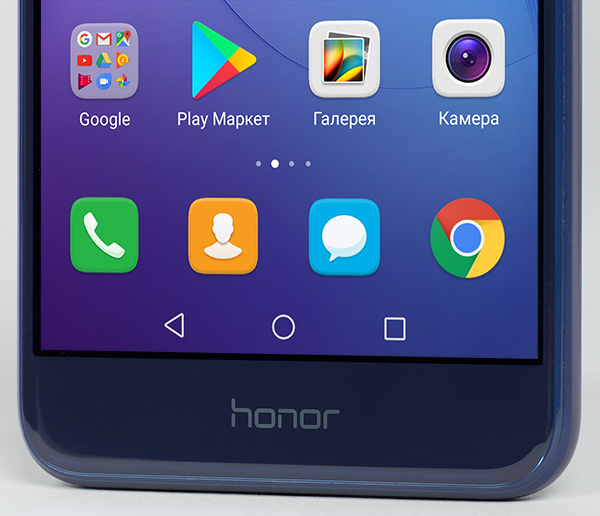
On the back of the case, a camera module with a single flash is installed, as protective glass they use the same common glass back panel, that is, the camera does not protrude beyond the surface. But the fingerprint scanner area located just below is slightly recessed, which is why it is easy to grope blindly.
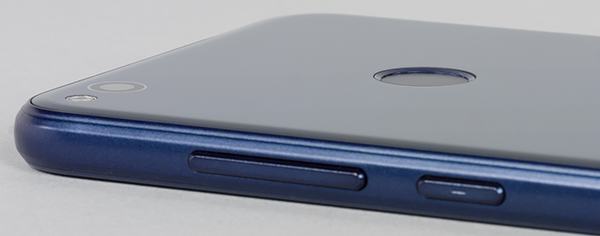
With the help of a fingerprint sensor, you can not only unlock the screen, but also control calls, scroll through the menu, alarm clock and take pictures on the camera. There are no complaints about the operation of the scanner, recognition is fast and error-free, a finger can be brought at any angle, up to five prints are recorded in memory.
The manufacturer claims: “The advanced fingerprint recognition system allows you to unlock Honor 8 Lite in just 0.3 seconds, uses a processor-level security system, and saved fingerprint patterns cannot be retrieved or restored.” In fact, the sensor really works quickly, there are no complaints, however, most modern fingerprint scanners have already reached the level where it has become difficult to single out any one in terms of response speed.
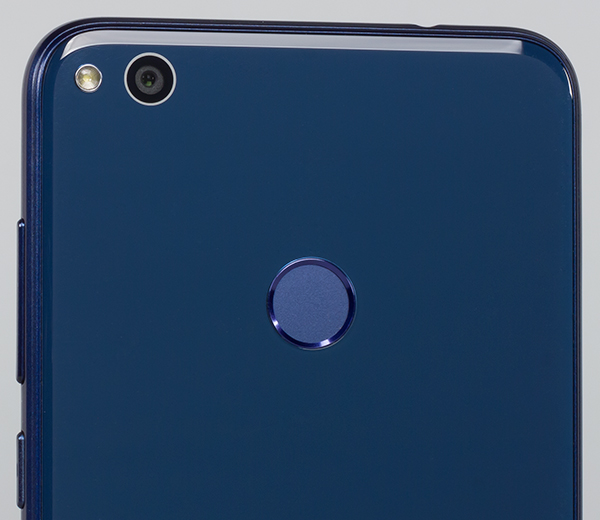
The Honor 8 Lite comes in four color options: black, white, gold and, of course, blue. For each of them, the front panel matches the color of the case itself.
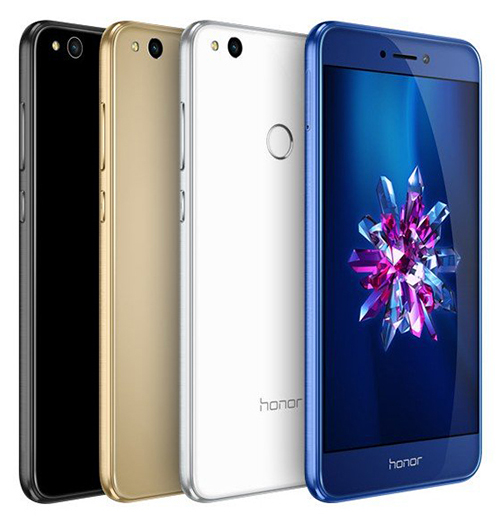
Screen
The Honor 8 Lite features an IPS display (with LTPS technology) with 2.5D glass with sloping edges. Its physical dimensions are 65 × 116 mm with a diagonal of 5.2 inches. The resolution is 1920 × 1080 pixels, the density is about 423 ppi. The frame around the screen has a total width of about 3.5 mm on the sides, 16 mm on the bottom, and 14 mm on the top.
The display brightness can be adjusted manually or you can use automatic settings based on the operation of the ambient light sensor. The AnTuTu test diagnoses support for 10 simultaneous multitouch touches. There is an eye protection mode to prevent eye fatigue.
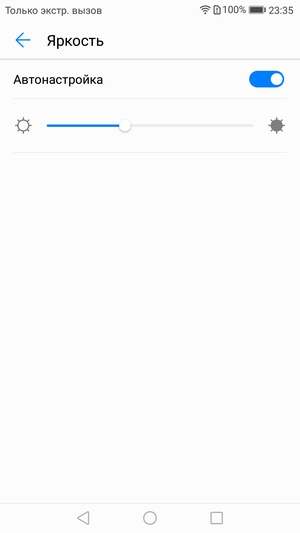 |
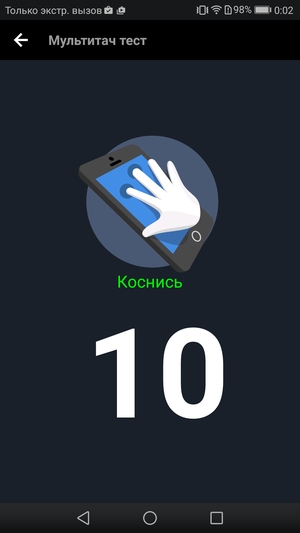 |
Detailed examination using measuring instruments held the editor of the sections "Monitors" and "Projectors and TV" Alexey Kudryavtsev. Here is his expert opinion on the screen of the test sample.
The front surface of the screen is made in the form of a glass plate with a mirror-smooth surface, resistant to scratches. Judging by the reflection of objects, the anti-glare properties of the screen are slightly worse than the screen of the Google Nexus 7 (2013) (hereinafter simply Nexus 7). For clarity, here is a photo in which a white surface is reflected in the off screens (on the left is Nexus 7, on the right is Honor 8 Lite, then they can be distinguished by size):
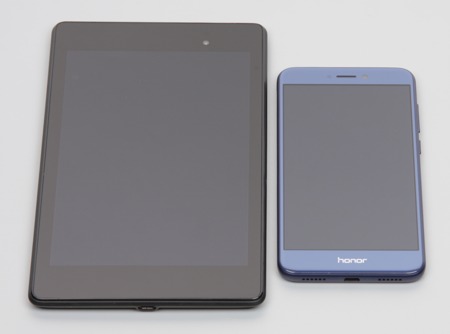
The screen of the Honor 8 Lite is a little lighter (brightness in the photos is 125 versus 113 for the Nexus 7). The doubling of reflected objects in the screen of Honor 8 Lite is very weak, which indicates that there is no air gap between the layers of the screen (more specifically, between the outer glass and the surface of the LCD matrix) (OGS type screen - One Glass Solution). Due to the smaller number of borders (glass/air type) with very different refractive indices, such screens look better in conditions of intense external illumination, but their repair in case of cracked external glass is much more expensive, since the entire screen has to be changed. On the outer surface of the screen there is a special oleophobic (grease-repellent) coating, which is even better in efficiency than the Nexus 7, so fingerprints are removed much easier and appear at a slower rate than in the case of ordinary glass.
When manually controlling brightness and when outputting a white field full screen the maximum brightness value was about 530 cd / m², the minimum - 6 cd / m². The maximum brightness is very high, and given the good anti-reflective properties, readability even on a sunny day outdoors should be at an acceptable level. In complete darkness, the brightness can be reduced to a comfortable value. In the presence of automatic brightness control by light sensor (it is located to the left of the front speaker slot). IN automatic mode as the ambient light conditions change, the brightness of the screen both increases and decreases. The operation of this function depends on the position of the brightness control, with which the user can try to set the required brightness level under the current conditions. We slightly increased the brightness in complete darkness and found that in complete darkness the auto-brightness function reduces the brightness to 14 cd / m², in an artificially lit office (approximately 550 lux) it sets to 170 cd / m², in a very bright environment (corresponds to clear lighting). during the day outdoors, but without direct sunlight - 20,000 lux or a little more) increases to 530 cd/m². The result satisfied us. It turns out that the auto-brightness function works adequately and to some extent allows the user to customize their work to individual requirements. At any brightness level, there is no significant backlight modulation, so there is no screen flicker.
This smartphone uses an IPS type matrix. Micrographs show a typical IPS subpixel structure:
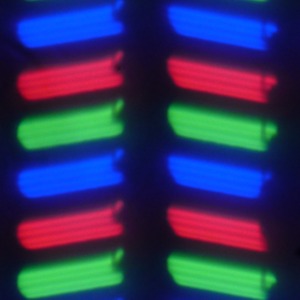
For comparison, you can see the gallery of microphotographs of screens used in mobile technology.
The screen has good viewing angles without significant color shift even at large deviations of the gaze from the perpendicular to the screen and without inverting shades. For comparison, here are photos in which the same images are displayed on the screens of Honor 8 Lite and Nexus 7, while the brightness of the screens was initially set to about 200 cd / m², and the color balance on the camera was forcibly switched to 6500 K.
White field perpendicular to the screens:
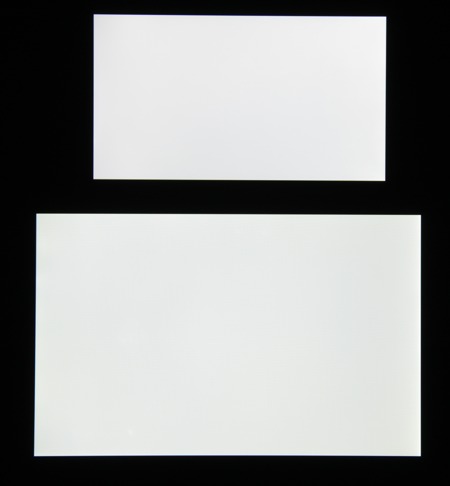
Note the good uniformity of brightness and color tone of the white field.
And a test picture:

Colors on the screen of Honor 8 Lite have a natural saturation, the color balance of the Nexus 7 and the tested screen is slightly different.
Now at an angle of about 45 degrees to the plane and to the side of the screen:
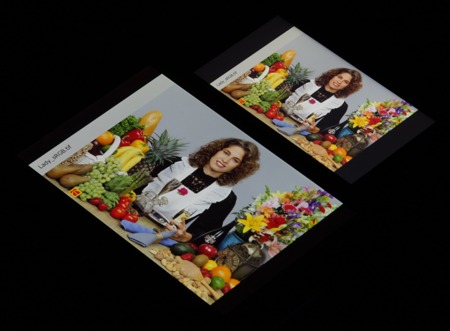
It can be seen that the colors have not changed much on both screens, but on the Honor 8 Lite, the contrast has decreased to a greater extent due to strong black highlighting.
And the white box:
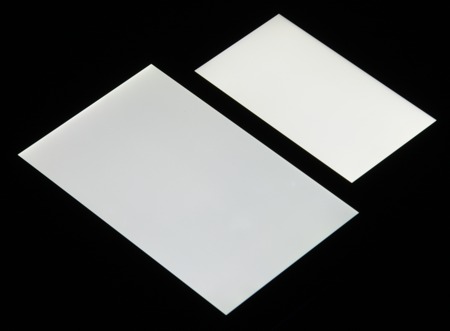
The brightness at an angle on the screens has decreased (at least 4 times, based on the difference in shutter speed), but in the case of Honor 8 Lite, the brightness drop is slightly less. The black field, when deviated diagonally, is highlighted strongly and acquires a reddish tint. The photos below demonstrate this (the brightness of the white areas in the direction perpendicular to the plane of the screens is the same!):
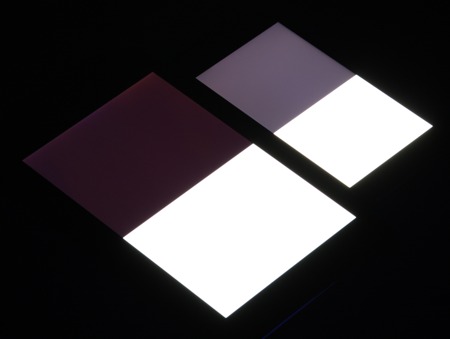
And from another angle:
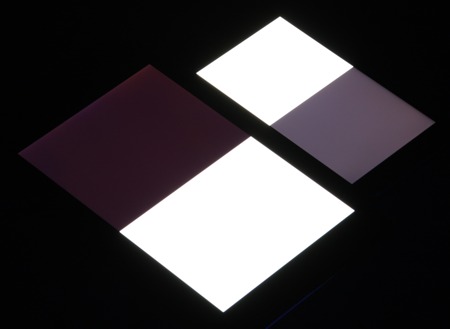
With a perpendicular view, the uniformity of the black field is average:
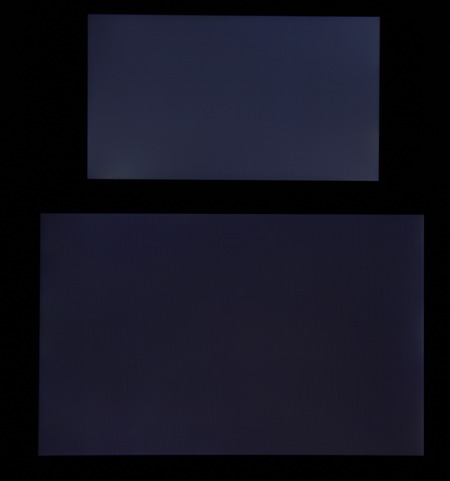
Contrast (approximately in the center of the screen) is high - about 1200:1. The response time for the black-white-black transition is 26 ms (14 ms on + 12 ms off). The transition between grayscale 25% and 75% (according to the numerical value of the color) and back in total takes 42 ms. The gamma curve constructed from 32 points with an equal interval according to the numerical value of the shade of gray did not reveal a blockage either in the highlights or in the shadows. The exponent of the approximating power function is 2.48, which is higher than the standard value of 2.2. In this case, the real gamma curve somewhat deviates from the power dependence:

This device has a dynamic adjustment of the brightness of the backlight in accordance with the nature of the displayed image - on dark average images, the backlight brightness noticeably decreases. As a result, the resulting dependence of brightness on hue (gamma curve) does not correspond to the gamma curve of a static image, since the measurements were carried out with sequential grayscale output almost on the entire screen. For this reason, we carried out a number of tests - determining contrast and response time, comparing black flare at angles - we carried out (however, as always) when displaying special patterns with a constant average brightness, and not monochromatic fields in full screen. In general, such a non-switchable brightness correction does nothing but harm, since a constant change in screen brightness can at least cause some discomfort, reduce the visibility of gradations in the shadows in the case of dark images and the readability of the screen in bright light, since the brightness of the backlight is not the brightest on average. is underestimated.
Color gamut close to sRGB:
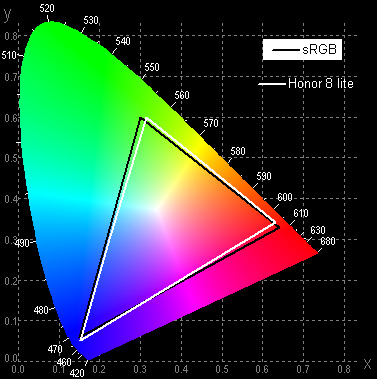
The spectra show that the matrix filters moderately mix the components to each other:

As a result, visually the colors on this screen do not differ from natural ones. The balance of shades on the gray scale is a bit of a compromise, since the color temperature is significantly higher than the standard 6500 K, but the deviation from the black body spectrum (ΔE) is below 10, which is considered an acceptable indicator for a consumer device. At the same time, the color temperature and ΔE change little from shade to shade - this has a positive effect on the visual assessment of color balance. (The darkest areas of the gray scale can be ignored, since the color balance does not matter much there, and the measurement error of color characteristics at low brightness is large.)
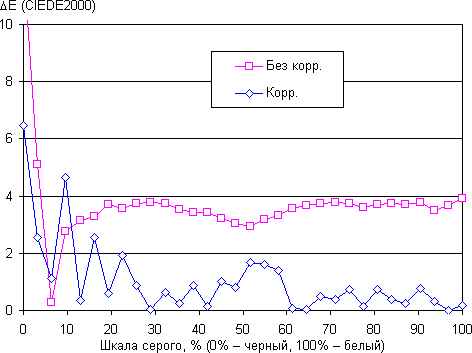
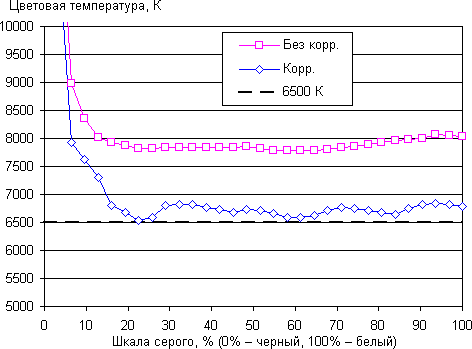
This device has the ability to correct the color balance by adjusting the hue on the color wheel.
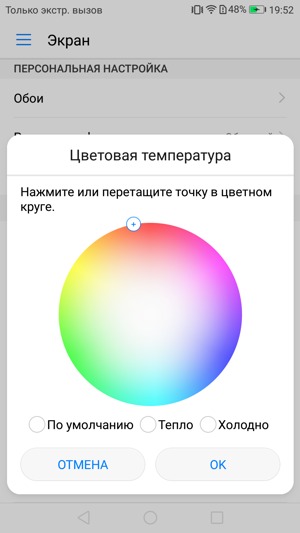
Curves in the charts above Without corr. correspond to the results without any color balance correction, and the curves Corr.— data obtained after shifting the point to the position indicated in the image above. It can be seen that the change in balance corresponds to the expected result, since the color temperature has approached the standard value and ΔE has decreased on average. There is some benefit from such a correction, besides, the brightness decreased by less than 14%. Note that this function is implemented in the variant rather for show, since there is no numerical reflection of the correction and there is no field for measuring the color balance.
There is a mod setting that allows you to reduce the intensity of the blue component.
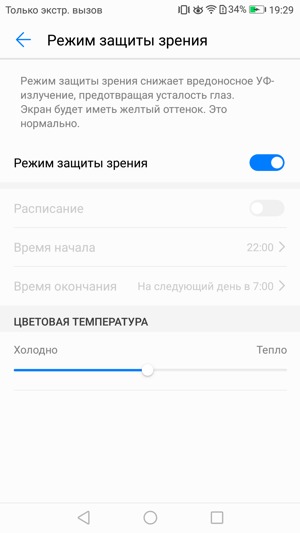
Marketers tried to intimidate the user to show the degree of care of the manufacturer. Of course, there is no UV radiation (see spectrum above), and there is no eye fatigue caused specifically by blue light. In principle, bright light can lead to disruption of the daily (circadian) rhythm (see article about), but everything is solved by adjusting the brightness to a comfortable level, and there is absolutely no point in distorting the color balance by reducing the contribution of blue.
To summarize: the screen has a very high maximum brightness and has good anti-glare properties, so the device can be used outdoors without problems even on a sunny summer day. In complete darkness, the brightness can be lowered to a comfortable level. It is permissible to use the mode with automatic brightness adjustment, which works adequately. The advantages of the screen include the absence of an air gap in the layers of the screen and flicker, an effective oleophobic coating, high contrast, an acceptable color balance and a color gamut close to sRGB. The disadvantages are the low stability of black to the deviation of the gaze from the perpendicular to the plane of the screen, as well as the non-switchable dynamic adjustment of the backlight brightness. Nevertheless, taking into account the importance of the characteristics for this particular class of devices, the screen quality can be considered high.
Camera
The front module here has an 8 MP sensor with a wide-angle lens (77 °) with an aperture of f / 2.0, with a fixed focus and without its own flash. Naturally, there is a mode for decorating a portrait, and for video shooting too. The Honor 8 Lite selfie camera shoots quite well: the image is bright, the detail is high, the colors are natural, the automatic white balance is adequate.
 |
 |
The main camera uses a module with a 12-megapixel matrix (pixel size 1.25 microns) and a lens with a maximum aperture of f / 2.2, there is a fast phase detection autofocus and a single, not very bright flash. There is no stabilization system. There is no second, auxiliary camera module here either, but there is a mode that allows you to change the focus point on an already finished picture.
 |
 |
As usual, there is a professional control mode in the settings. If you turn it on, a horizontal slider will appear with adjustable shutter speed (from 1/4000 to 8 s), ISO (up to ISO 1600), metering method, focus options, white balance and exposure compensation scale. As for the additional modes, in addition to the mentioned variable focus mode, as well as HDR, there are a lot of scene modes, including those downloaded additionally (food mode, light painting, etc.). Using Camera2API, you can transfer control of the camera to third-party applications, as well as save pictures in RAW.
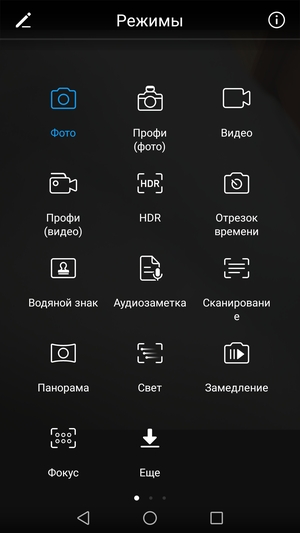 |
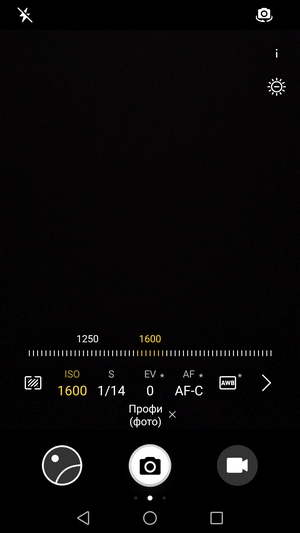 |
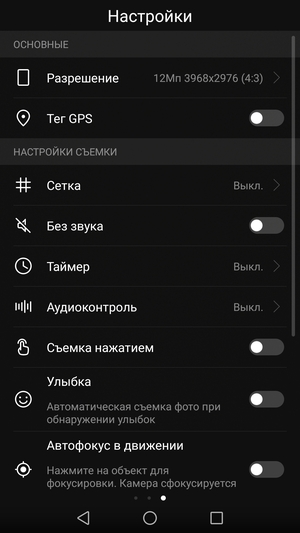 |
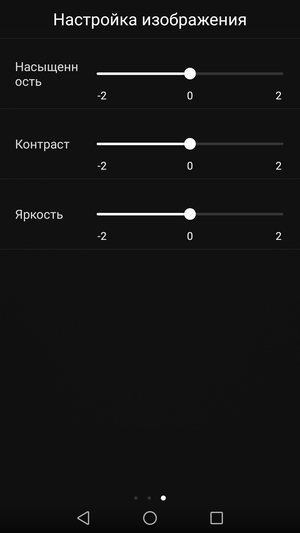 |
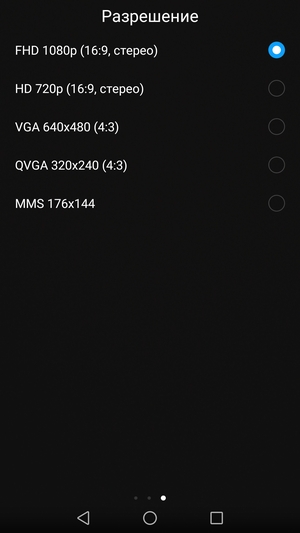 |
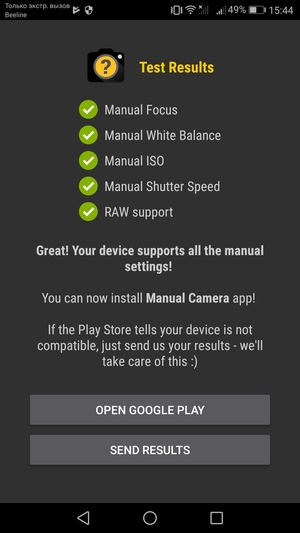 |
The camera can shoot video at maximum Full resolution HD @30 fps, there is a slow motion mode. There is no stabilization function, but it would not hurt here, since small hand tremors are noticeable even with static shooting, but not to mention shooting in motion. The picture itself is juicy and of quite high quality, there are no complaints about the detail and smoothness of the video sequence, as well as the sound. The noise cancellation system does its job well.
- Clip #1 (34 MB, 1920× [email protected] fps, H.264, AAC)
- Clip #2 (16 MB, 1920× [email protected] fps, H.264, AAC)
 |
Good sharpness across the frame. Numbers of the nearest cars are distinguishable. |
 |
The camera does a good job with macro photography. |
 |
Good detail in the distance. |
 |
The text is well done. |
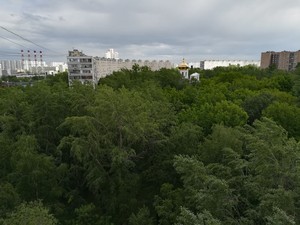 |
Good detail plans. |
 |
The field of detail is also good. |
The camera can be called good, as follows from the comments to the pictures. It boasts high detail and sharpness across the field and according to the plans. You can find small areas of blur, but these are trifles. The program also works well in the camera: there are practically no noises, and the noise reduction is quite accurate. Perhaps, in terms of quality, this module is not much inferior to its older brother in the Honor 8 model marked Pro. As a result, the camera will perfectly cope with many scenarios.
Telephone part and communications
The communication capabilities of the Honor 8 Lite include support for LTE Cat.6 (up to 300 Mbps), a sufficient number of LTE FDD and TDD frequency bands are supported, but only two of the three FDD LTE bands we are interested in (band 3 and 7) are among them, and Here the band 20 range is not supported by the device. In the city limits of the Moscow region, the device behaves confidently, the quality of signal reception does not cause any complaints.
However, only one Wi-Fi band (2.4 GHz) is supported, NFC is not. You can standardly organize a wireless access point via Wi-Fi or Bluetooth 4.1 channels. The Micro-USB connector supports connecting external devices in USB OTG mode. The navigation module works with GPS (with A-GPS) and with Glonass. The first satellites are detected during a cold start within a minute, the positioning accuracy is not bad. There is a magnetic compass.
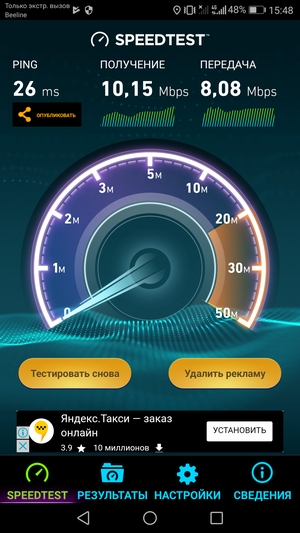 |
 |
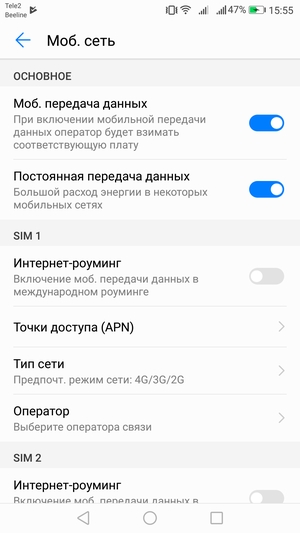 |
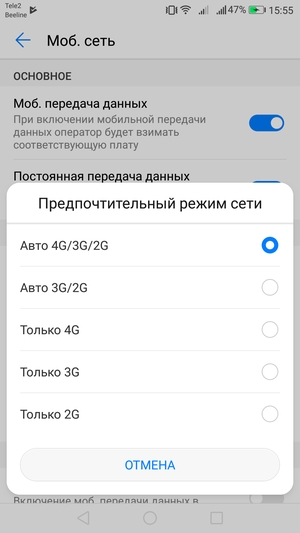 |
The phone application supports Smart Dial, the ways of sorting and displaying contacts are standard for the Android interface.
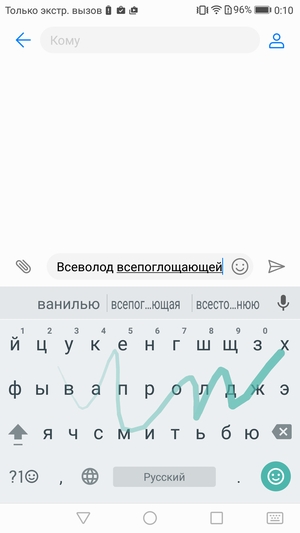 |
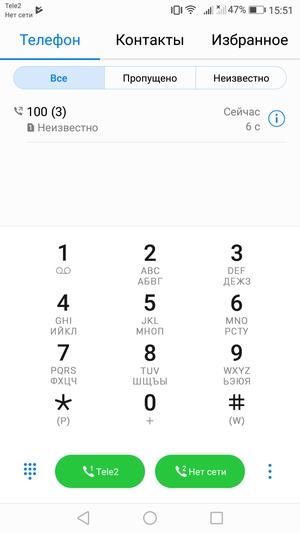 |
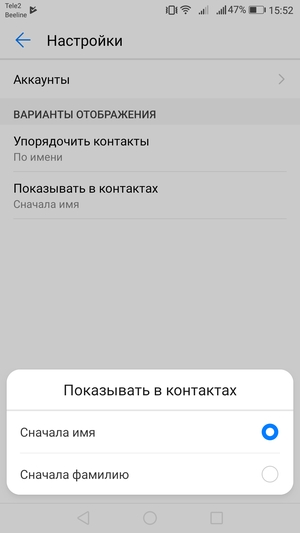 |
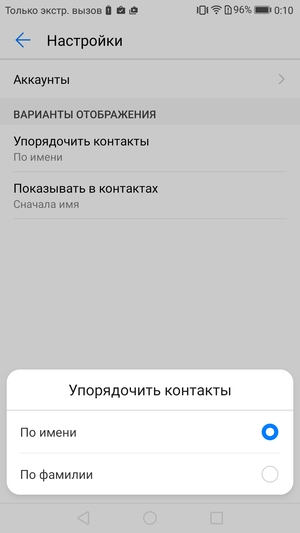 |
The smartphone does not support both SIM cards in 3G/4G mode at the same time in active standby mode. That is, when one card is assigned for data transmission in 4G, the second one can only work in 2G. The interface does not allow you to select a specific SIM card for SMS in advance - only during the connection. But you can pre-select a card for data transfer and voice calls. The cards work in Dual SIM Dual Standby mode, there is only one radio modem.
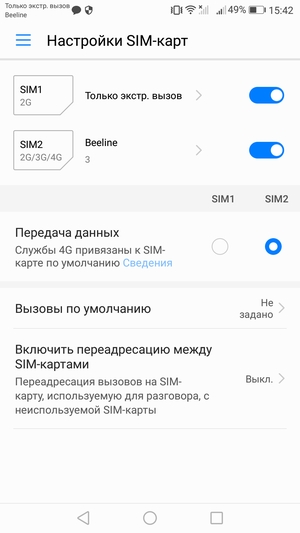 |
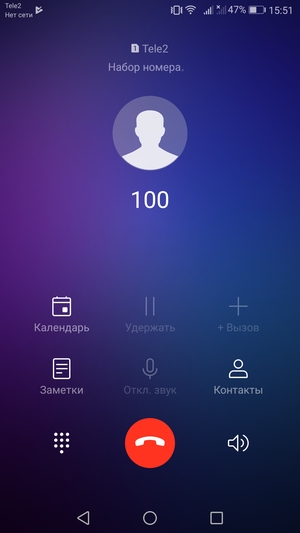 |
Software and multimedia
As a software platform, Honor 8 Lite uses the latest versions of Android OS (7.0) and branded shell EMUI (5.0), it is possible to update over the air. This isn't the first time we've seen EMUI 5.0, so we already know that the UI was inspired by the rich colors of the Aegean. In terms of organization in EMUI, you can find all the features that a modern mobile device interface needs: there is a two-window mode, gesture support, a virtual button, and much more. In the launcher, you can use the “Asian” version without a separate application menu or the standard Android interface more familiar to Europeans with a separate application menu.
Among the installed applications, you can usually find a comprehensive phone manager, there is a health monitoring program, a file manager. From third party applications for the Russian-speaking market, as usual, pre-installed free services Yandex and Mail.ru, as well as Booking.com and TripAdvisor. Traditionally for Huawei smartphones the way to switch language layouts is inconvenient: instead of the usual pressing of one button, here you need to hold the spacebar and then slide to the target, which takes more time. In addition, an alternative SwiftKey keyboard with an extended set of settings is preinstalled.
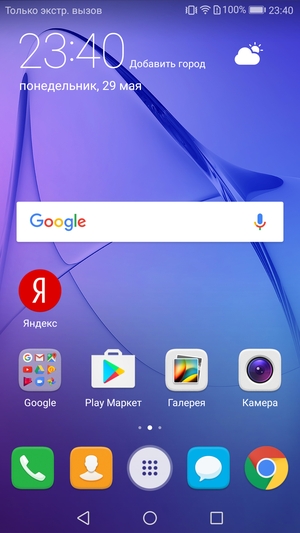 |
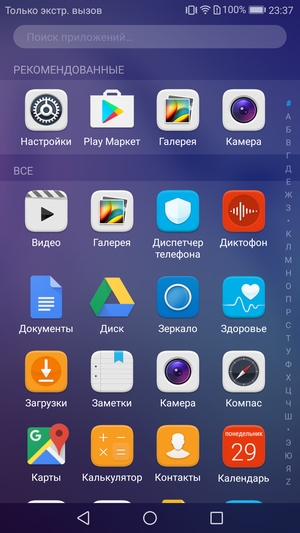 |
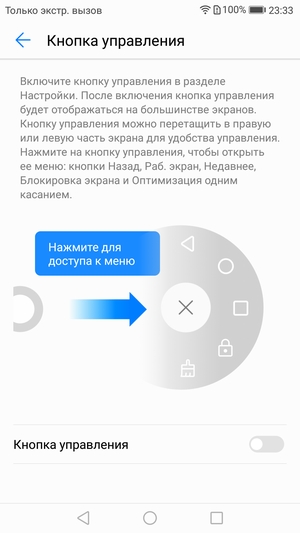 |
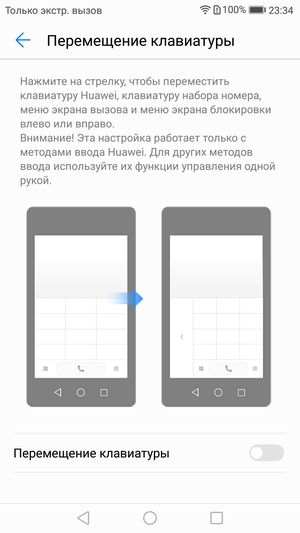 |
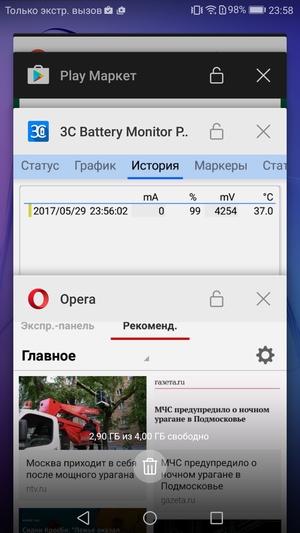 |
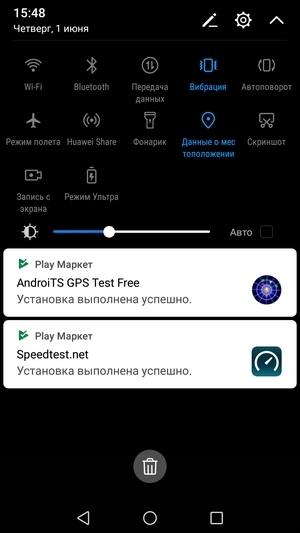 |
For music, a familiar branded player with a familiar interface is intended, in which there are no manual settings at all - you can only turn the SWS virtual system on or off. Both in headphones and through the main speaker, the device sounds average: the sound is clear, but unpretentious, sonorous, without a noticeable presence of low frequencies, the volume is sufficient, but not excessive. There is an FM radio without the ability to record programs from the air. The microphone demonstrates satisfactory sensitivity, the voice recorder is working.
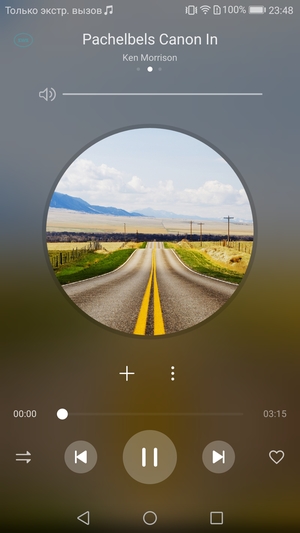 |
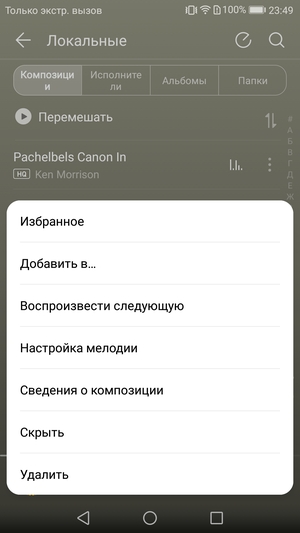 |
 |
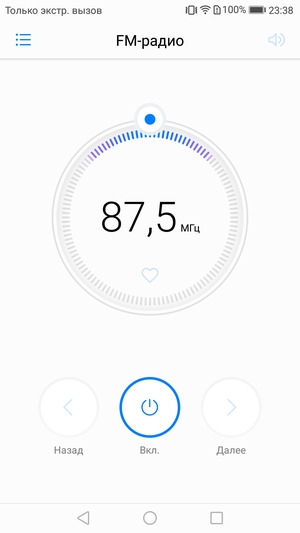 |
Performance
The hardware platform of Honor 8 Lite is based on a HiSilicon Kirin 655 single-chip system, made using 16-nanometer technology. This SoC includes eight 64-bit ARM Cortex-A53 cores in two clusters: up to 2.1 GHz and 1.7 GHz. The dual-core GPU Mali-T830 MP2 is responsible for graphics processing. The amount of RAM is 3 or 4 GB, and the built-in flash memory is 32 or 64 GB. In our version of the smartphone, less than 22 of the 32 GB of flash memory and approximately 2.5 of the 4 GB of RAM were free. The possibility of expanding the built-in memory by installing microSD cards yes, but then you have to remove one of the SIM-cards.
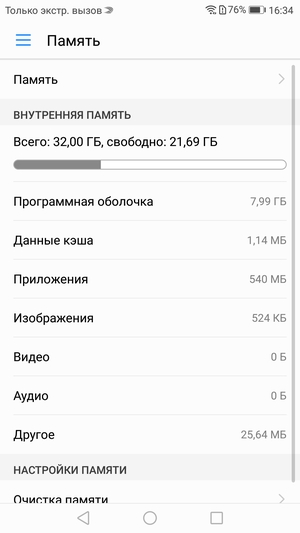 |
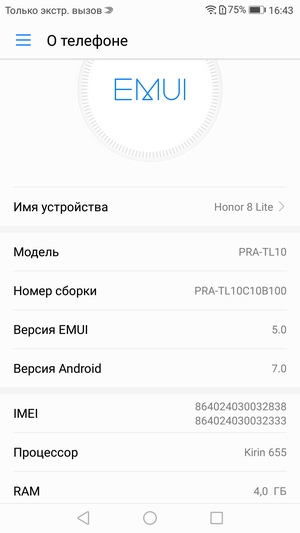 |
In general, Kirin 655 demonstrates quite a confident average level according to the results of all tests. The platform's capabilities are somewhere between the Qualcomm Snapdragon 430 and Snapdragon 625. In the comprehensive AnTuTu test, the Kirin 655 delivers about 57K points.
The performance of Honor 8 Lite is still enough to perform any task, including for current games, which, for example, in the case of Mortal Kombat X, go briskly, without braking.
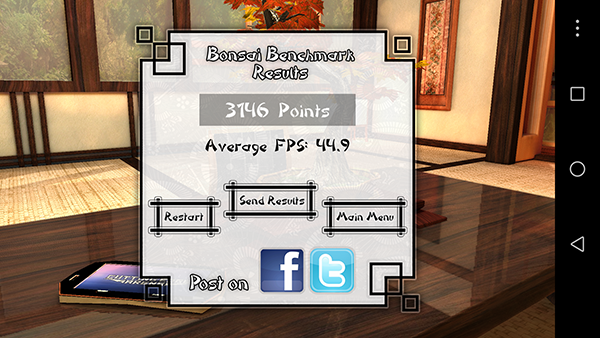
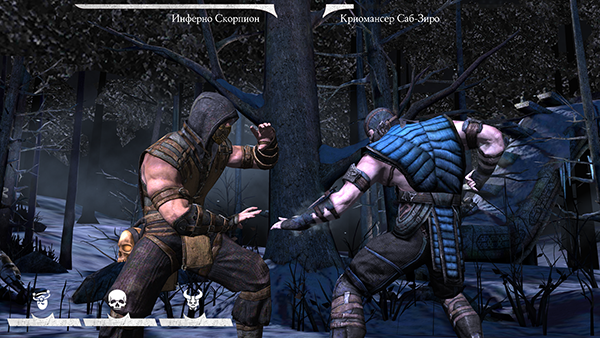
Testing in comprehensive AnTuTu and GeekBench tests:
For convenience, we have summarized all the results obtained by us when testing a smartphone in the latest versions of popular benchmarks in tables. Several other devices from different segments are usually added to the table, also tested on similar latest versions benchmarks (this is done only for a visual assessment of the obtained dry numbers). Unfortunately, within a single comparison, it is impossible to present the results from different versions benchmarks, so many worthy and relevant models remain “behind the scenes” - due to the fact that they once passed the “obstacle course” on previous versions test programs.
 |
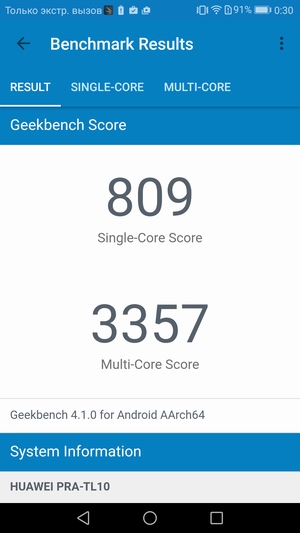 |
Testing the graphics subsystem in 3DMark gaming tests, GFXBenchmark and Bonsai Benchmark:
When testing in 3DMark for the highest performing smartphones, it is now possible to run the application in Unlimited mode, where the rendering resolution is fixed at 720p and VSync is disabled (due to which the speed can rise above 60 fps).
| Honor 8 Lite (HiSilicon Kirin 655) |
Honor 6C (Qualcomm Snapdragon 435) |
HTC One X10 (MediaTek Helio P10 (MT6755)) |
Lenovo K6 Note (Qualcomm Snapdragon 430) |
Asus Zenfone 3 (Qualcomm Snapdragon 625) |
|
| 3DMark Ice Storm Sling Shot ES 3.1 (more is better) |
398 | 254 | 421 | 288 | 466 |
| GFXBenchmark Manhattan ES 3.1 (Onscreen, fps) | 5 | 11 | 5 | 4 | 6 |
| GFXBenchmark Manhattan ES 3.1 (1080p Offscreen, fps) | 5 | 5 | 5 | 4 | 6 |
| GFXBenchmark T-Rex (Onscreen, fps) | 19 | 28 | 17 | 15 | 22 |
| GFXBenchmark T-Rex (1080p Offscreen, fps) | 18 | 16 | 17 | 16 | 23 |
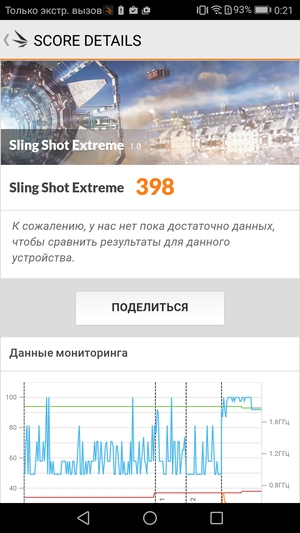 |
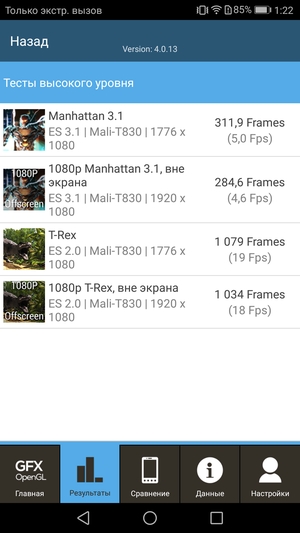 |
Browser cross-platform tests:
As for benchmarks for evaluating the speed of the javascript engine, you should always make allowances for the fact that the results in them depend significantly on the browser in which they are launched, so that the comparison can only be truly correct on the same OS and browsers, and this possibility is available when testing not always. In the case of Android OS, we always try to use Google Chrome.
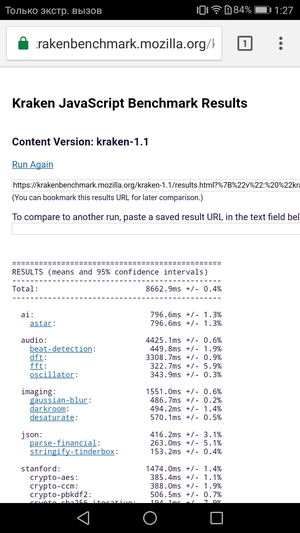 |
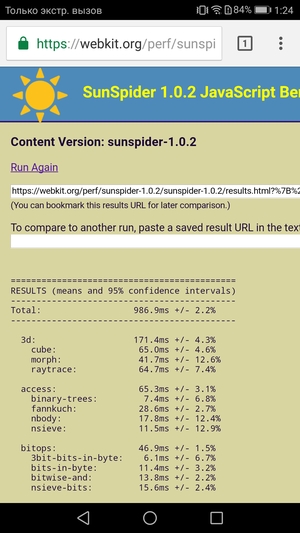
results AndroBench test on the speed of working with memory:
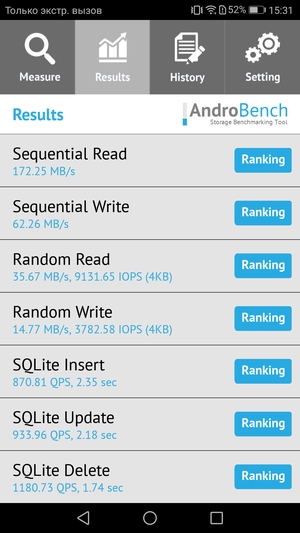
thermal images
Below is a thermal image rear surface obtained after 10 minutes of running a battery test in the GFXBenchmark program:
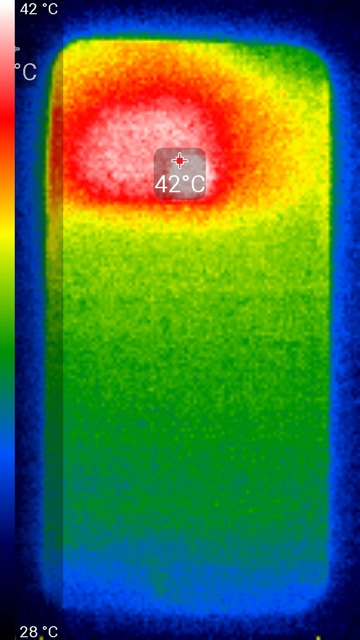
Heating is more localized in the upper part of the device, which apparently corresponds to the location of the SoC chip. According to the heat chamber, the maximum heating was 42 degrees (at an ambient temperature of 24 degrees). Such heating cannot be called insignificant.
Video playback
To test the "omnivorous" when playing video (including support for various codecs, containers and special features, such as subtitles), we used the most common formats, which make up the bulk of the content available on the Web. Note that for mobile devices it is important to have support for hardware video decoding at the chip level, since it is most often impossible to process modern versions using processor cores alone. Also, do not expect everything from a mobile device to decode everything, since the leadership in flexibility belongs to the PC, and no one is going to challenge it. All results are summarized in a table.
| Format | container, video, sound | MX Video Player | Regular video player |
| 1080p H.264 | MKV, H.264 1920×1080, 24fps, AAC | plays normally | plays normally |
| 1080p H.264 | MKV, H.264 1920×1080, 24 fps, AC3 | plays normally | |
| 1080p H.265 | MKV, H.265 1920×1080, 24fps, AAC | plays normally | plays normally |
| 1080p H.265 | MKV, H.265 1920×1080, 24 fps, AC3 | plays normally | video plays fine, no sound |
Further testing of video playback performed Alexey Kudryavtsev.
We did not find an MHL interface, as well as Mobility DisplayPort, in this smartphone, so we had to limit ourselves to testing the output of video files on the screen of the device itself. To do this, we used a set of test files with an arrow and a rectangle moving one division per frame (see "Methodology for testing video signal playback and display devices. Version 1 (for mobile devices)"). Screenshots with a shutter speed of 1 s helped determine the nature of the output frames of video files with different parameters: the resolution varied (1280 by 720 (720p), 1920 by 1080 (1080p) and 3840 by 2160 (4K) pixels) and frame rate (24, 25, 30, 50 and 60 fps). In tests, we used the MX Player video player in Hardware mode. The test results are summarized in the table: Red marks indicate possible problems associated with the playback of the respective files.
According to the criterion for displaying frames, the quality of playing video files on the screen of the smartphone itself is good, since in most cases frames (or groups of frames) can (but are not required) to be displayed with more or less uniform alternation of intervals and without frame drops. The screen refresh rate is 59 Hz, so in the case of 60 fps files, at least one frame per second is skipped. When playing video files with a resolution of 1920 by 1080 pixels (1080p) on a smartphone screen, the image of the video file itself is displayed exactly along the border of the screen, one to one in pixels, that is, in its original resolution. The brightness range displayed on the screen corresponds to the standard range of 16-235: all gradations of shades are displayed in the shadows and in the highlights.
Battery Life
The non-removable battery installed in Honor 8 Lite has a capacity of 3000 mAh. With this battery, the smartphone demonstrates quite satisfactory autonomy results, but nothing more. In real usage scenarios, with a normal average mode of operation, the hero of the review is quite capable of calmly holding out without recharging for one full day, but you should not count on more.
Testing was traditionally carried out at the usual level of power consumption without the use of power saving functions, although these, of course, are provided in the device.
Continuous reading in the Moon + Reader program (with a standard, light theme) at a minimum comfortable brightness level (brightness was set to 100 cd / m²) with auto scrolling lasted about 13.5 hours until the battery was completely discharged, and with continuous video viewing in high quality(720p) with the same brightness level through wifi network the device operates for approximately 10.5 hours. In 3D gaming mode, the smartphone can work up to 4.5 hours.
From standard network adapter with a maximum output current of 2 A, the smartphone is charged in approximately 2 hours and 40 minutes with a current of 1.6 A at a voltage of 5 V. The smartphone does not support wireless charging.
Outcome
Honor 8 Lite turned out to be very attractive in appearance and quite worthy of technical specifications. With a price of 12-15 thousand rubles (depending on the modification), he has every chance to gain popularity and become a worthy successor to the legendary Honor family. For a small amount of money for the official Russian retail, the buyer receives a nice thin balanced device with a bright screen, quite up-to-date hardware stuffing, satisfactory communication capabilities, sound, autonomy and a good camera for its level. The company is positioning Honor 8 Lite as a smartphone for active and fashion-conscious young people who prefer to buy stylish and productive devices at low prices. affordable price. And in general, the novelty fully justifies itself in this role.

